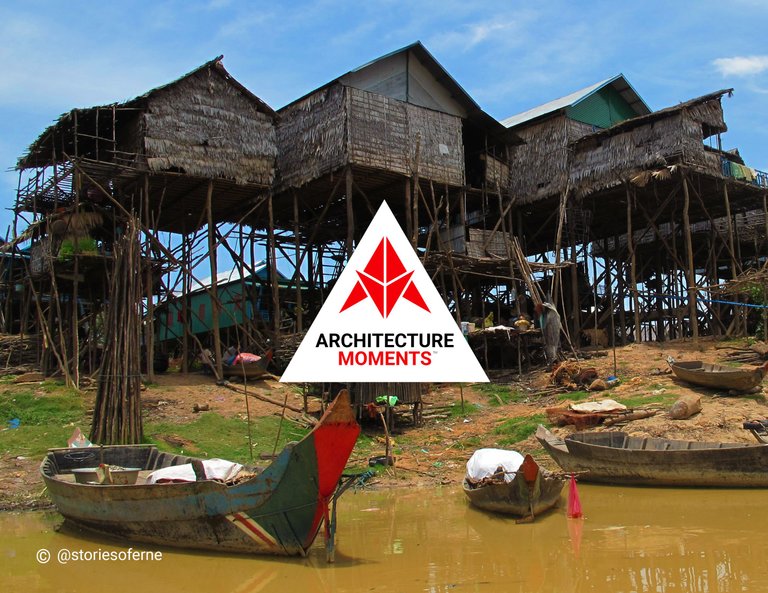
Hunt for Vernacular Habitats
"Vroom, vroom, vroom!" My hired Tuk Tuk, a vehicle with a 2-wheeled open-air carriage pulled by a motorcycle commonly used for public commutes in Cambodia, roared its powerful engines like a lion as its speedy tires raced through the dusty streets of the countryside. The outdoor temperature was peaking scorching levels, probably around 40 degrees Celsius (104°Fahrenheit), and as I was wiping my sweaty face and neck with my portable towel, a cool breeze slapped my body, thus compensating for the harsh weather. With my digital camera on hand, we were heading towards the remote neighborhoods, far away from the city center, to experience at close range this nation's local residential architecture. My plan for that day's journey was to capture photographic souvenirs, starting first with the land-based environments, and then capping off with the water-based houses.
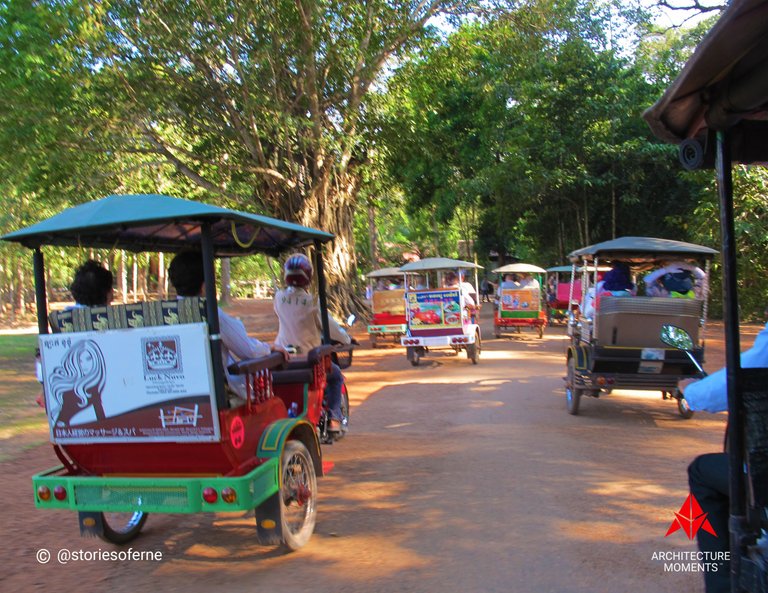
Welcome to Episode 8 of Architecture Moments™. Join me as we investigate the traditional Khmer Houses of Cambodia, particularly the structures situated on the rural vicinities of Siem Reap, also known as the cradle of the iconic Angkor Wat, the world's largest religious monument. Recognized as Cambodia's second-largest metropolis, it's also a vibrant center of vast temple ruins, cultural museums and villages, handicraft outlets, ethnic Apsara dance shows, silk sanctuaries, rice fields, fishing villages, and an international hub for dining, drinking, plus other forms of entertainment. With its diverse offerings, tourists and locals alike consider the city a promising destination. In fact, I was never bored during my week-long vacation there.
Stilt Architecture of Siem Reap
You would simply be amazed at the rural Khmer houses, as they were scattered all over the place. Whichever side I glanced at while cruising on the Tuk Tuk, there were interesting versions to be explored. For some of these abodes, we had to stop on the sidewalks to get a closer look. Fortunately, the local inhabitants I've met, with their friendly nature and warm reception, freely consented for their homes to be photographed. Isn't that wonderful?
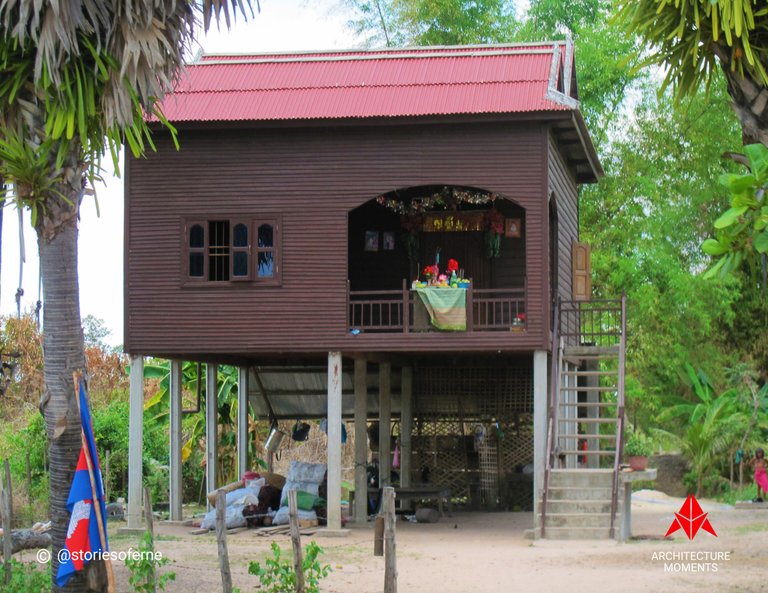
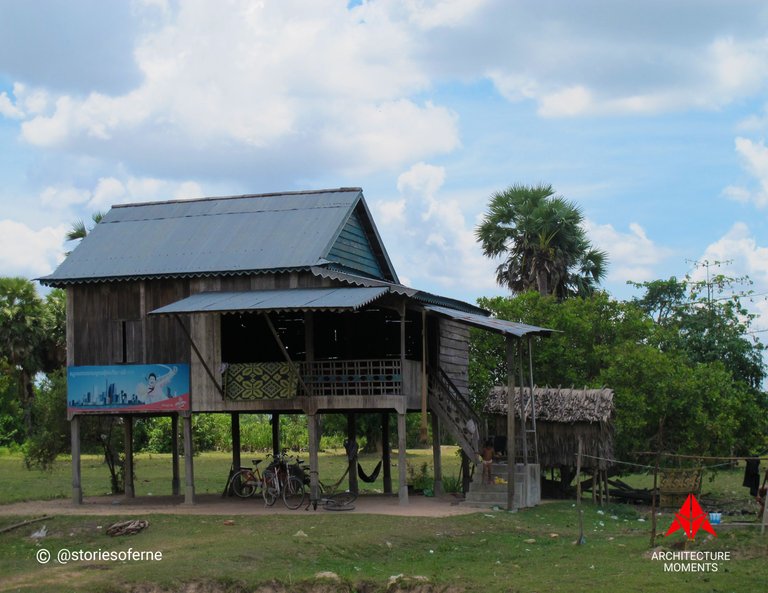
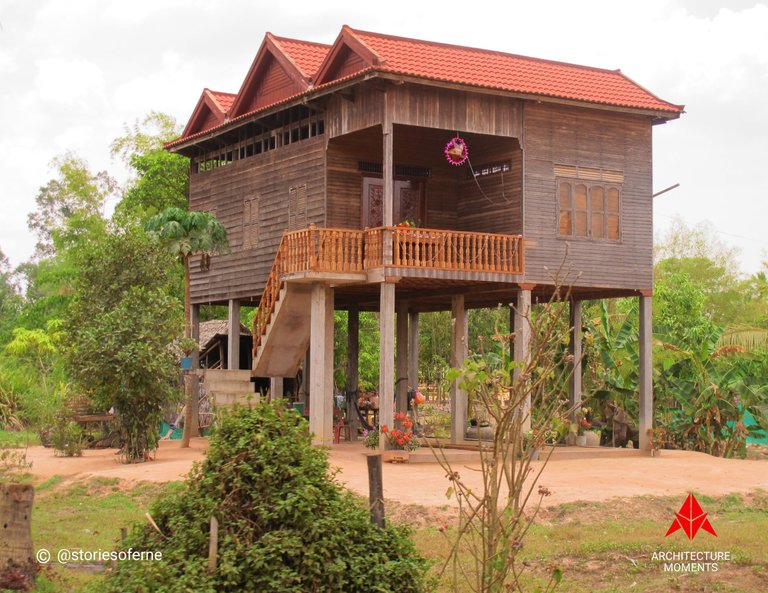
These humble habitats were typically two-storey buildings, consisting of varying floor dimensions from 4 meters (13 feet) by 6 meters (20 feet) to approximately 6 by 10 meters (33 feet). Their fundamental skeleton consisted of wooden frameworks, and the roofing system was usually built first before walls were installed on the second level. These roof shapes dictated the type of house styles such as a hipped roof (Phteah Pét), a gabled roof (Phteah Rông Daol), and a bonnet roof (shikoro in Japanese) used to describe the Khmer house (Phteah Keung).
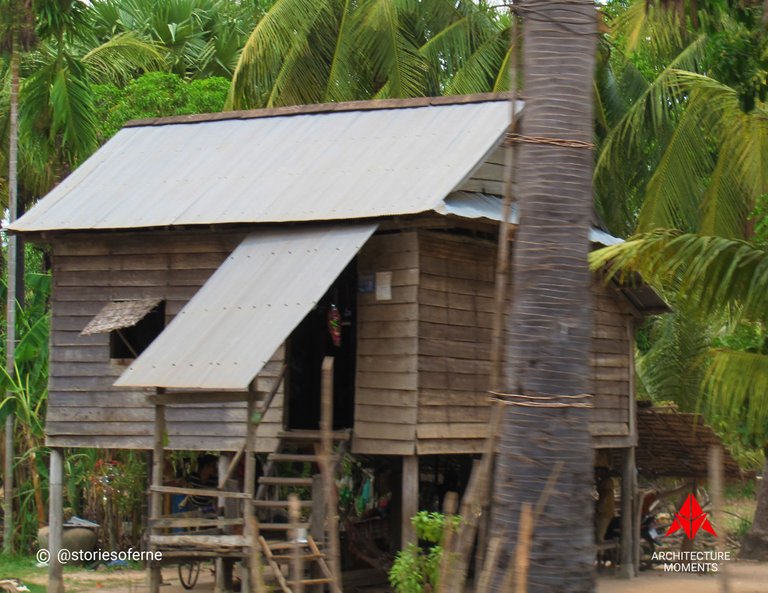
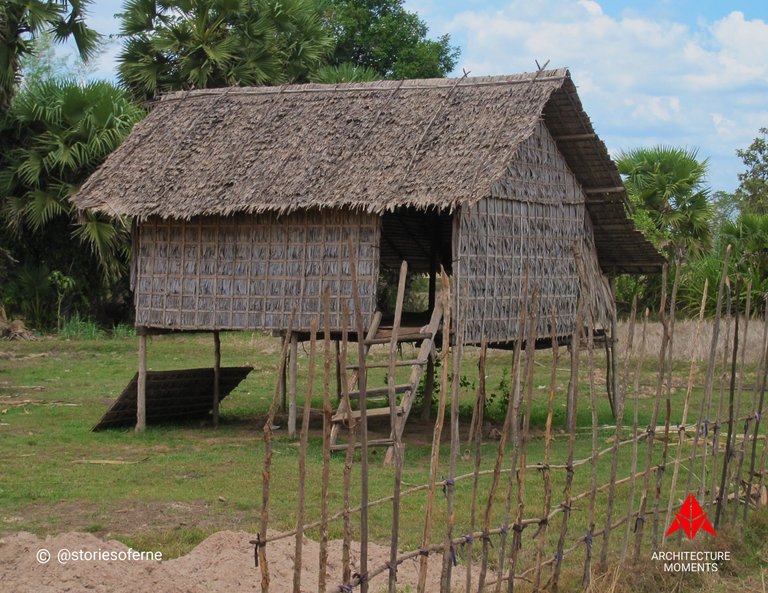
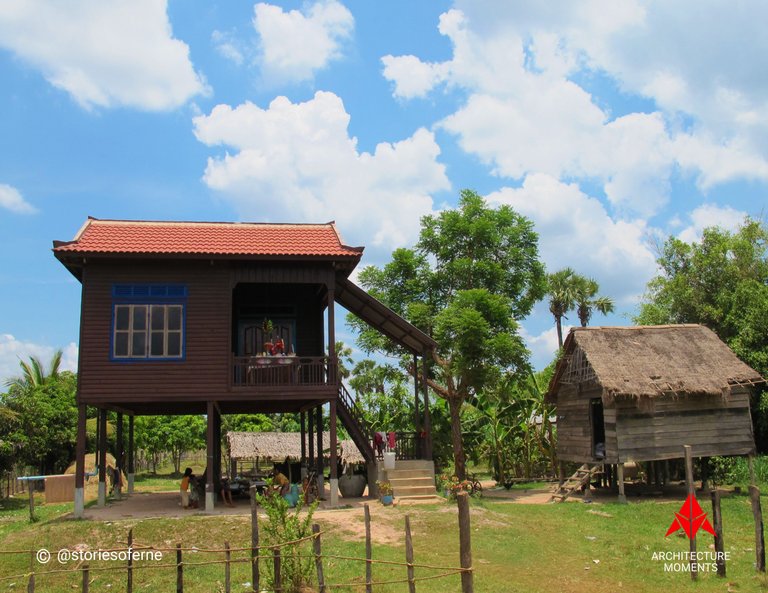
Some of these houses had open spaces (attics) underneath the roofs that served as storage compartments for rice. These features were common in the province of Battambong and were known as Phteah Rông Doeung which signified that a rice mill was installed at the back of the house beneath a secondary awning. One of the most recognizable details was a 5-10 centimeter gap on four sides of the top portion of the upper floor's walls and its roof.
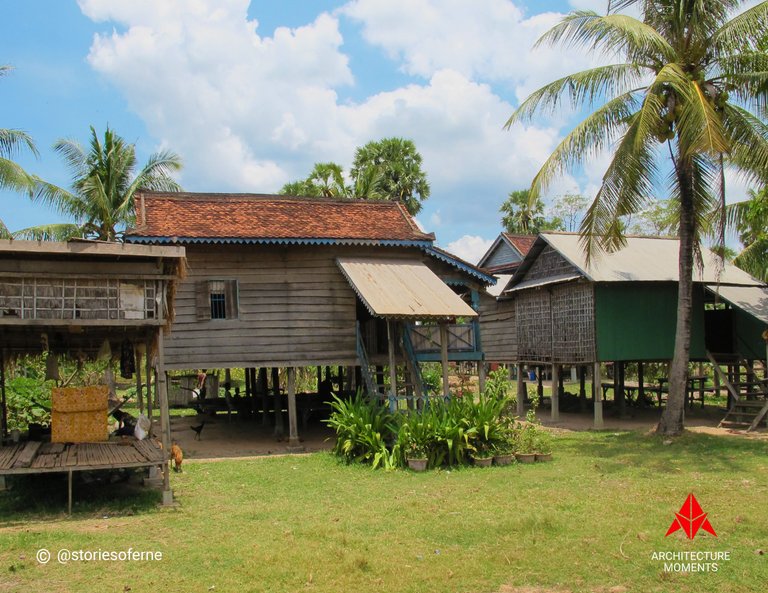
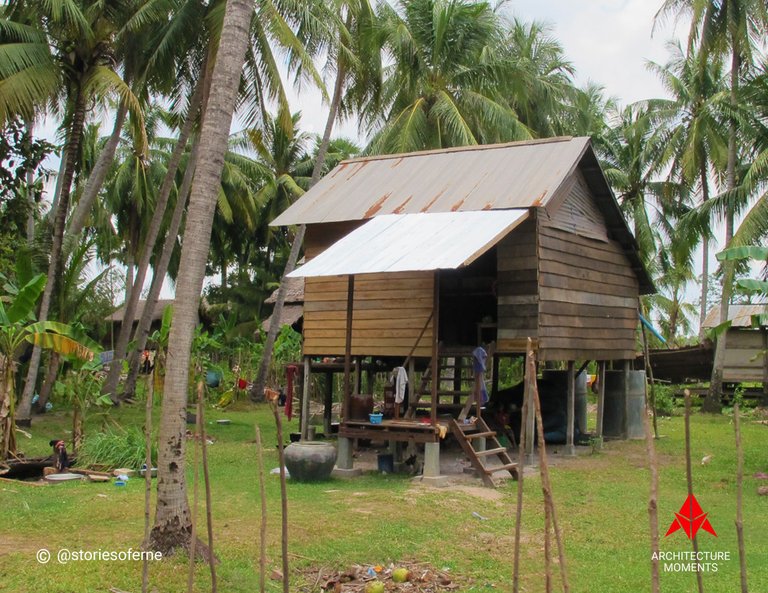
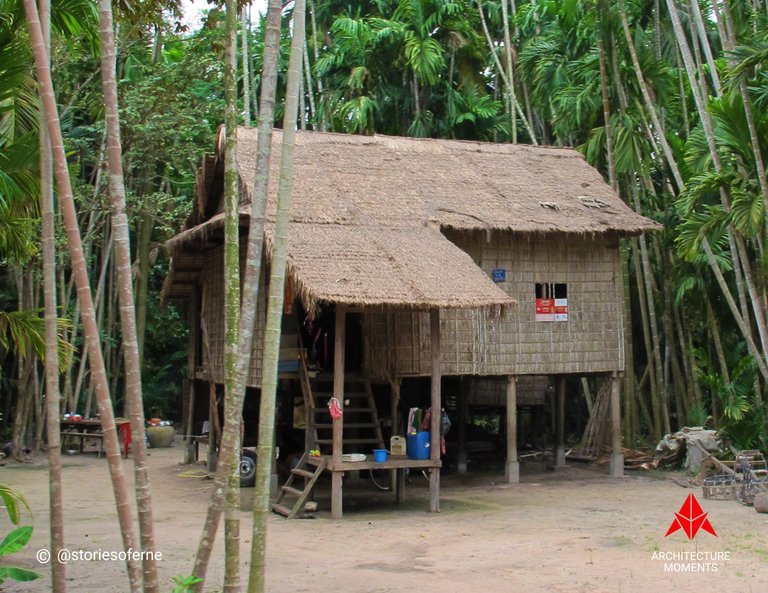
What else have you noticed so far? If there was one common denominator that provided these traditional Cambodian dwellings their distinctive functions, that would be the STILTS. These were long vertical poles or piles made of wood (sometimes concrete) that served as the main structural supports. These elevated houses on stilts were raised as high as 3 meters (9.8 feet) above the ground. I've also seen a single ladder (seldom two), ramps, and staircases that were the means of access to the upper levels.
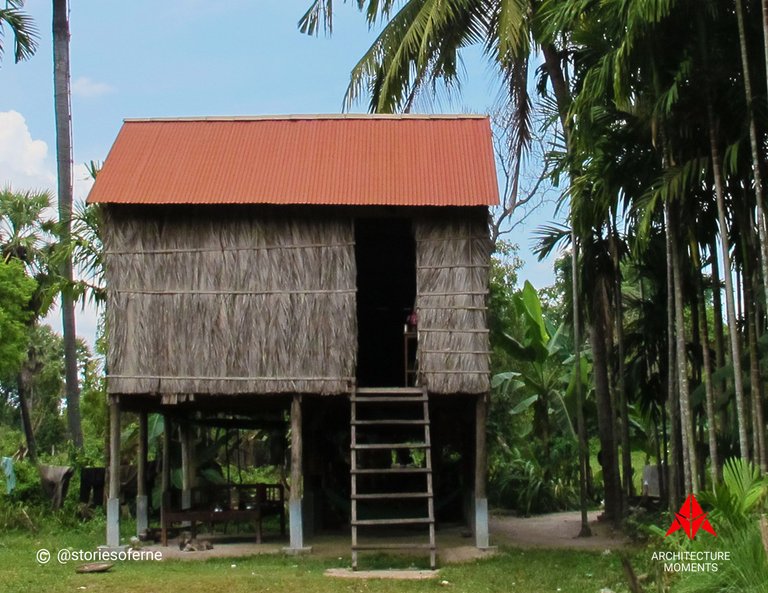
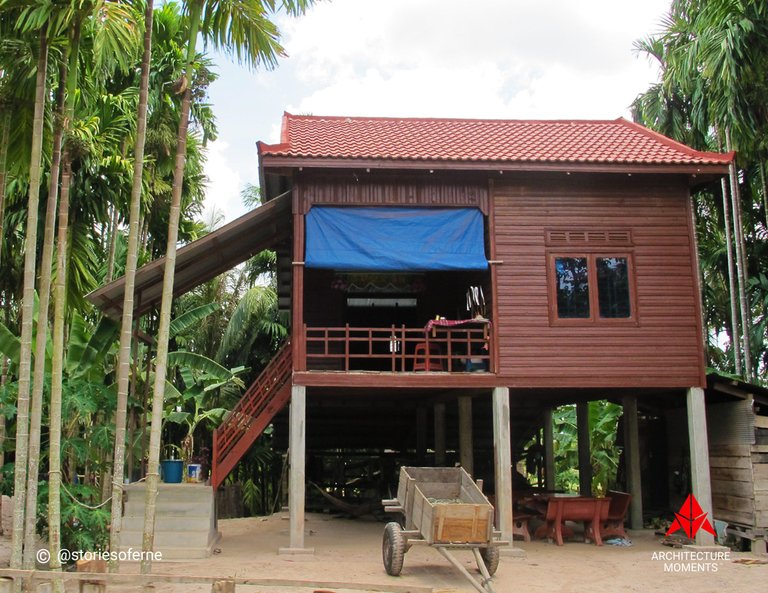
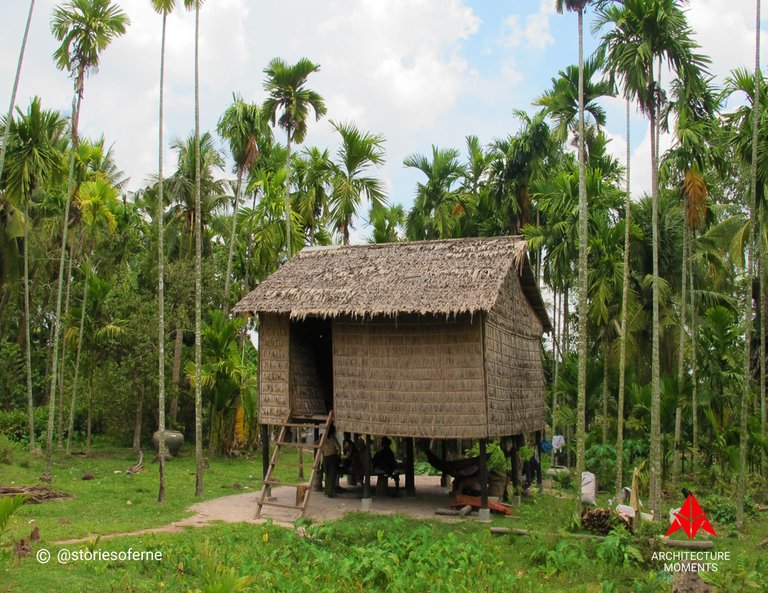
During my observations, there were plenty of valid reasons why they had to construct their residential habitats on stilts. Here are a few of the major ones:
Inhabitants were safeguarded against flash floods and were protected from dangerous animals like snakes, wild boars, and other harmful pests.
Open spaces on the ground levels provided shade against the sun and working areas for the occupants and were also used for keeping animals and other livestock.
These simplified structures were not planned for air-conditioning that harness electricity but were purposefully designed with open spaces below to allow natural ventilation to easily flow through its roofs, walls, and floors. Hence, these practical systems assisted in cooling down the whole dwelling.
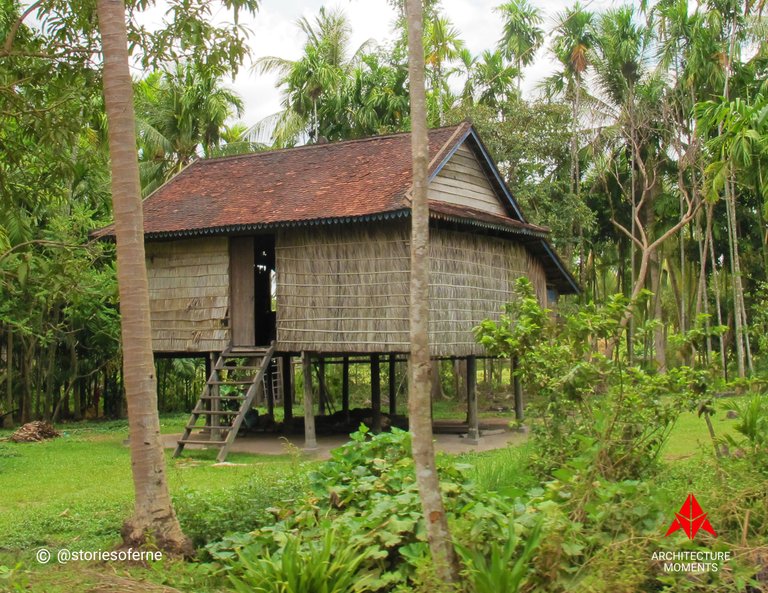
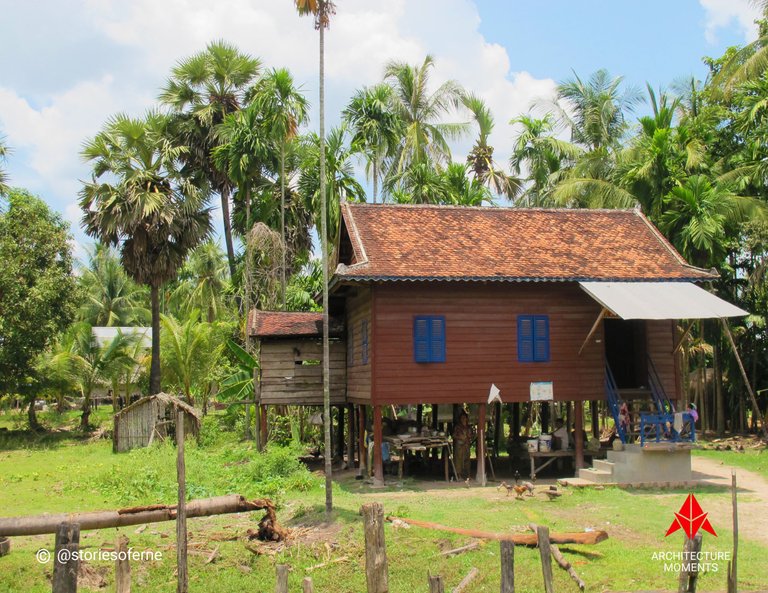
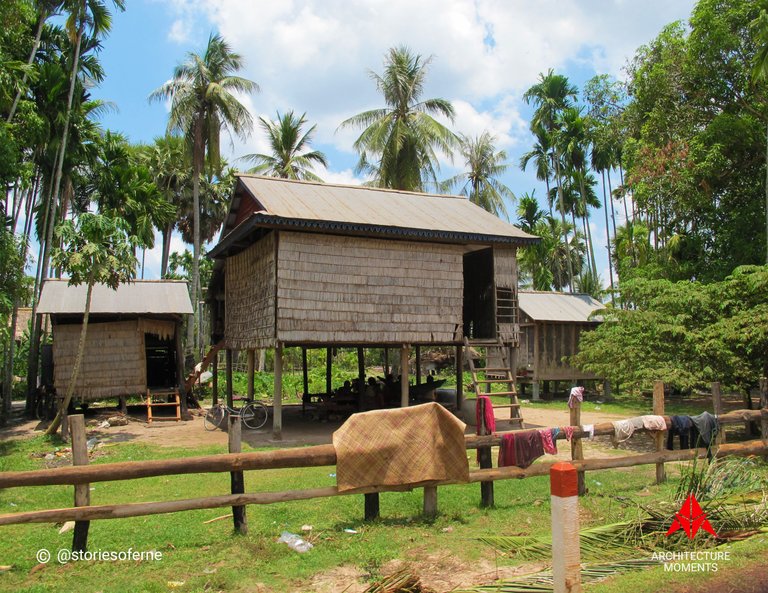
The most basic of these housing units only had one room, usually subdivided with textile partitions that separated a main receiving area for visitors, a storage area, a bedroom (sleeping space) for parents or elders, and the rest of the sections for children. The manner by which these functional compartments were organized varied for every family, but kids were always separated according to their gender. The kitchen is typically detached from the main house more often located at the back. But if part of the main building, it's lowered below with a few steps. The toilet, in particular, is seldom a pit on the ground isolated from the house. They also stored large jars filled with rainwater outdoors to be used for washing, cleaning, bathing, and for other important purposes.
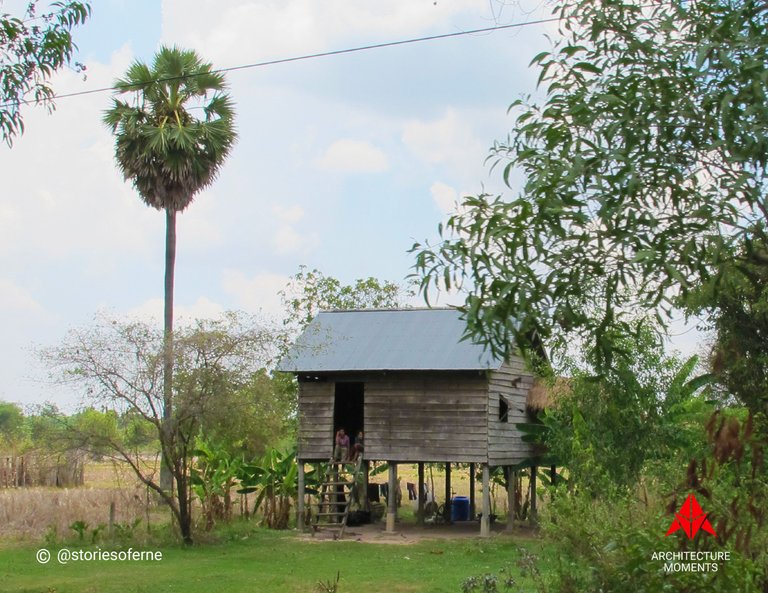
I was truly impressed with their land dwellings! The rural Khmer house was certainly an ideal demonstration of functionality. Aside from offering living and working spaces, these constructed habitats also provided shelter, the core ingredient required for a Cambodian home for protection against the challenging climatic elements.
Wandering in the Middle of Nowhere
It was around noon already, and our bellies were grinding with hunger. So, we decided to drop by one of the modest restaurants along the way and grabbed our quick lunch there. Afterward, while continuing our road trip, we suddenly bumped into an uncommon scenario.
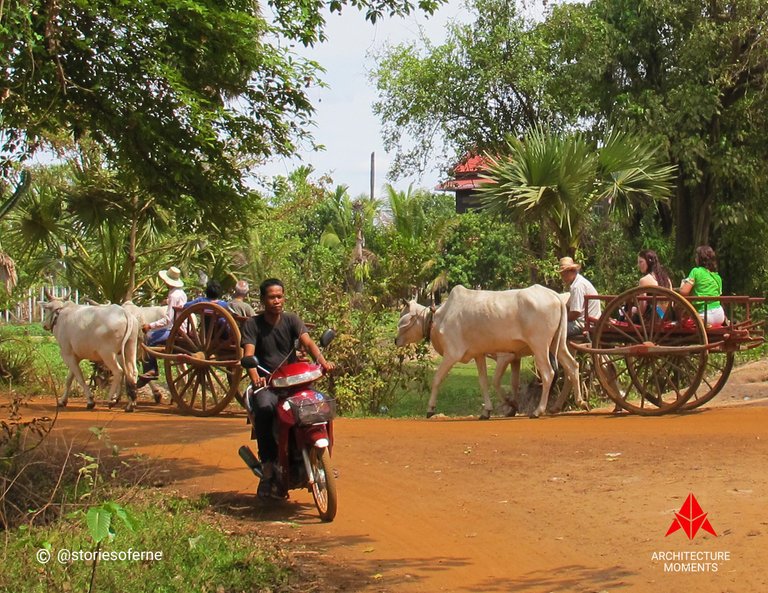
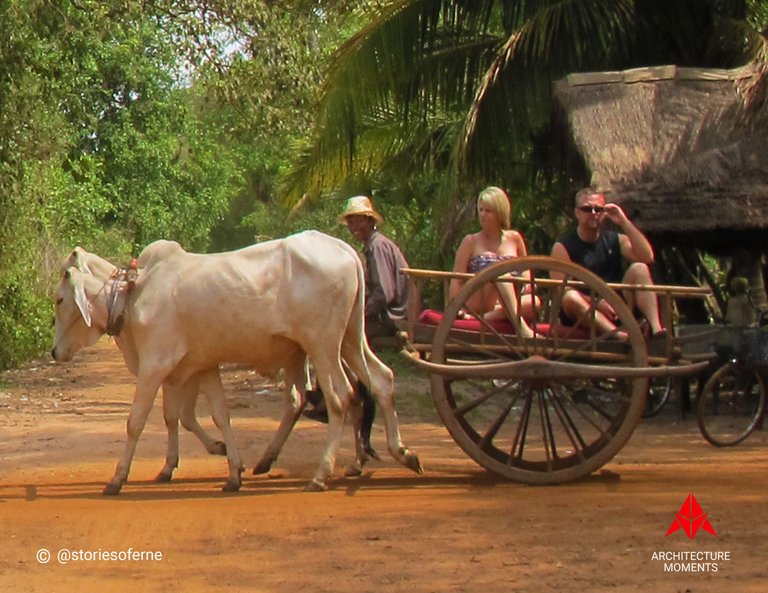
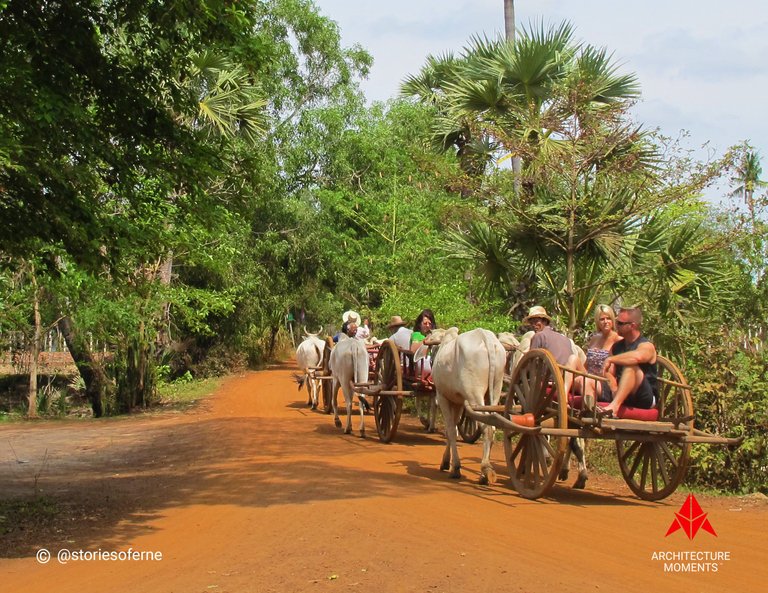
"Holy cow! Aren't they having a fantastic time? That's surely an awesome way to explore the countryside!" I exclaimed as our Tuk Tuk passed an interesting caravan of foreign tourists accompanied by their local drivers. I took a snappy picture as they were quickly moving in the opposite direction. If my entire voyage was similar to a full-length movie, this unexpected incident would definitely make a nice commercial break, haha.
And then, in an instant, there were no more houses in plain sight. They all seemed to have disappeared in thin air! After a few moments, we arrived at an open field where you could view the horizon and beyond. There was nothing else spectacular to be seen in that place except for enormous rice paddies, busy farmers working, giant bushes, and an unprecedented number of ducks doing their thing.
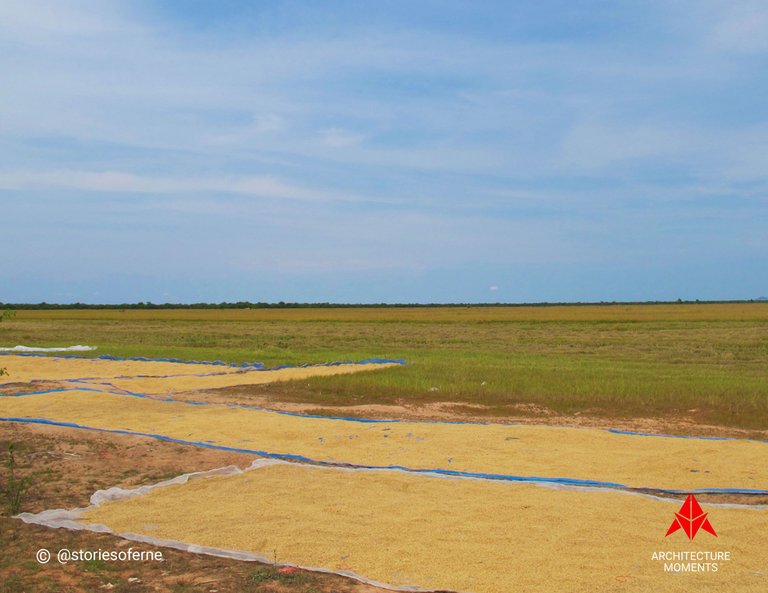
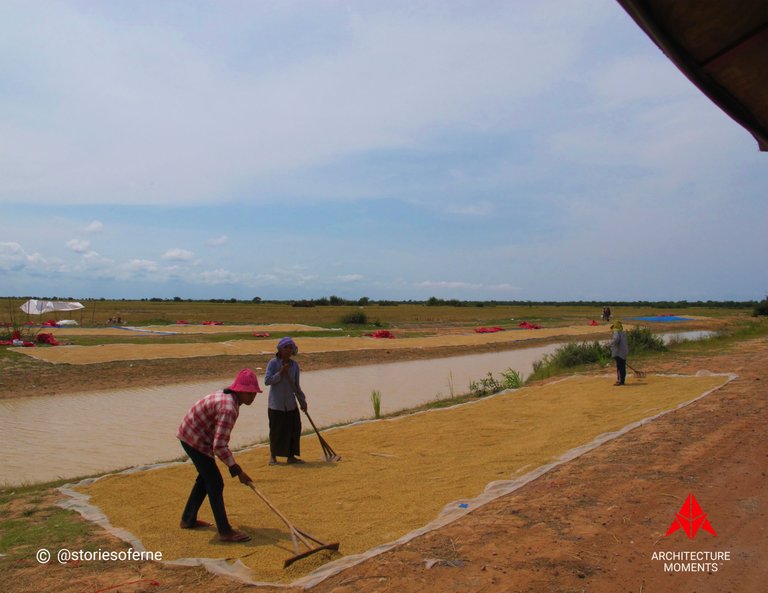
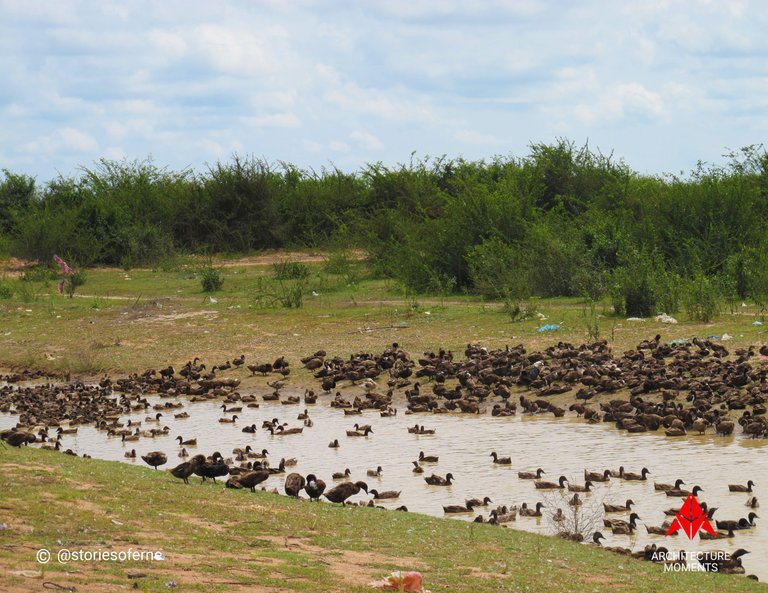
"Hey. where are we now? Are we lost?" I asked my Tuk Tuk driver who also happened to be my personal tour guide for that special trip.
"No Sir, we're not. We're now in a transition. There's still so much more to see and experience up ahead. And you're in for a big surprise, I promise!" he answered. (Oh well, because he wasn't a fluent English speaker, these were not his exact words. However, this was merely my own interpretation of his optimistic response. Get the gist?...lol)
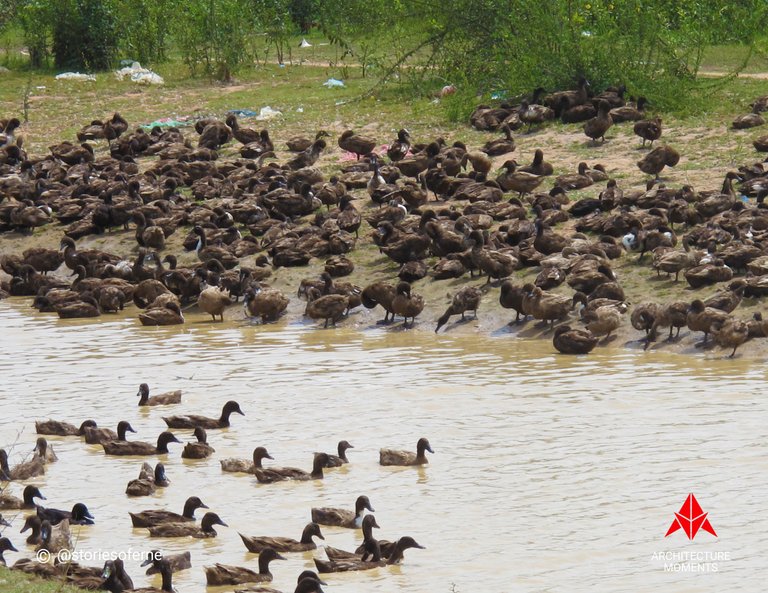
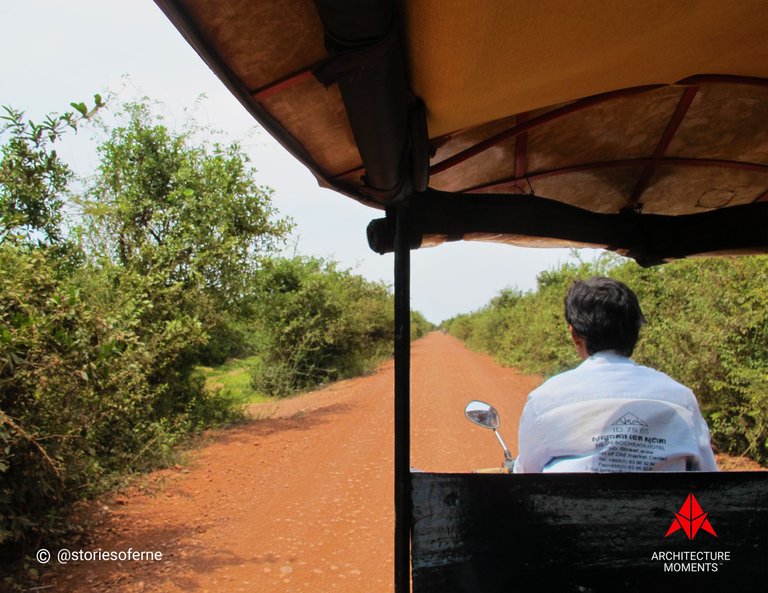
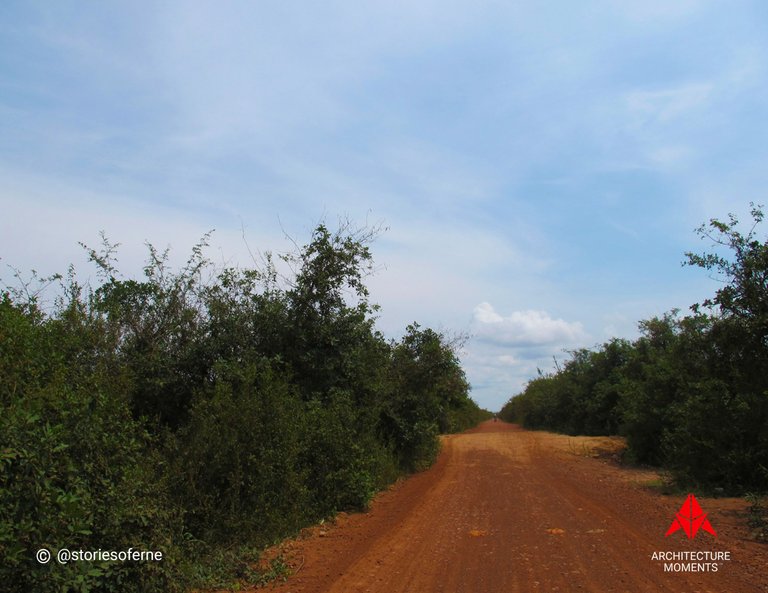
You see, some of the most exciting adventures while traveling in an unfamiliar destination can be discovered off the beaten path. Do you agree? Without a single clue on where I was at that point, this mysterious location could probably be one of them. Nevertheless, there was no need to be stressed out. So, I took it easy and invested my full confidence in my trustworthy companion.
Modest Welcome of Tonle Sap Lake
Meeting me on my arrival was a group of colorful wooden boats that lay side by side along a shallow channel of muddy water. I had no idea that we were already close to the mouth of the largest freshwater lake in Southeast Asia: Tonle Sap. But, before visiting this huge aquatic environment, we had no choice but to pass through a narrow stream and experience an exotic floating village prior to getting there. Oh boy, were my feet really itchy!
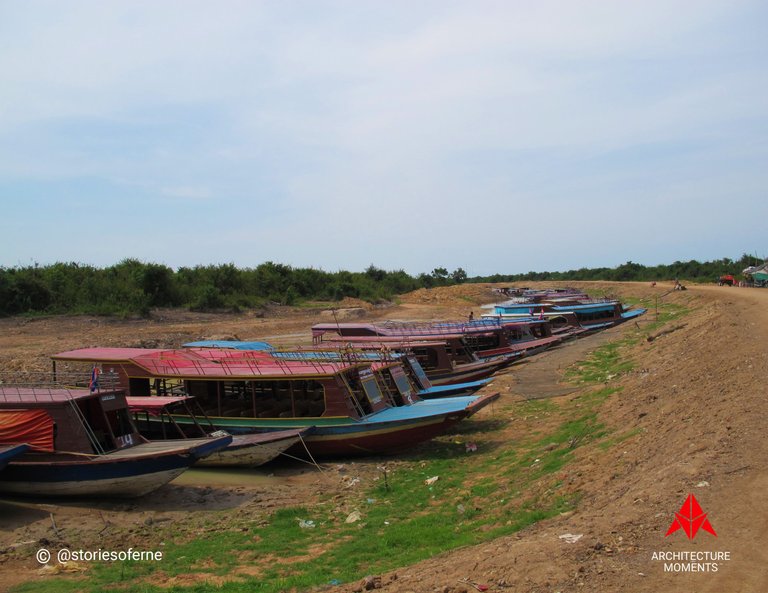
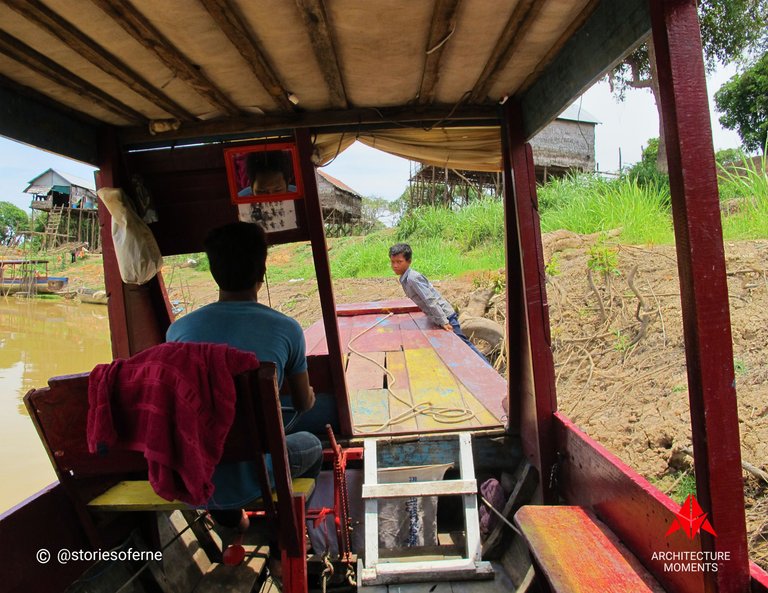
The Tonle Sap Lake was waiting. So without wasting time, I immediately boarded my chosen boat as we prepared for the adventure. Two resident villagers served as my humble crew as we commenced the snail-paced cruise. Our watercraft had to move forward at this slow speed due to the shallow depths of the muddy stream. It was also a clever method of preventing the boat's propeller from unnecessarily splashing dirty debris everywhere.
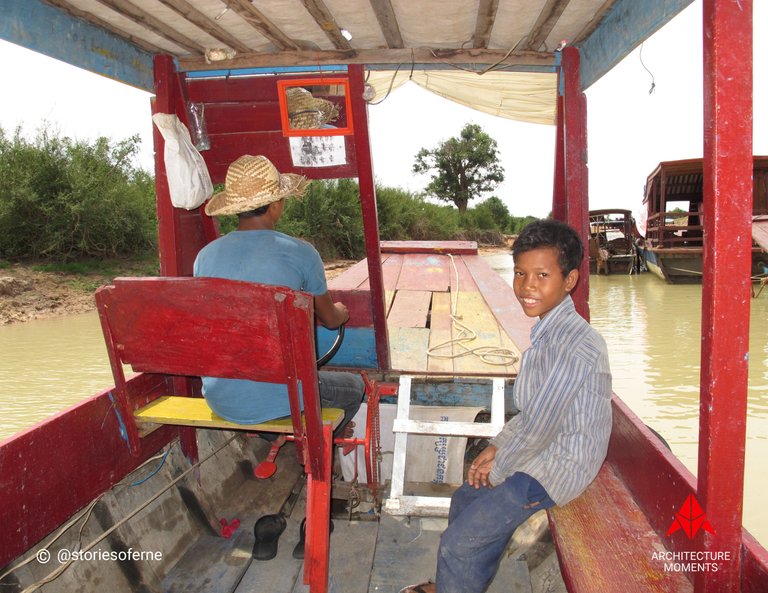
Let me introduce to you my friendly buddy for that ride. Aside from being the boat's assistant captain, he was there to answer my questions, ensure safety, and be our extra pair of eyes. In fact, he was already well-versed in dealing with tourists. And I'm pretty sure that his frequent exposure to daily visitors must have given him the required courage, skills, and determination to earn extra income for his family. Thus, I was glad he was up to the task.
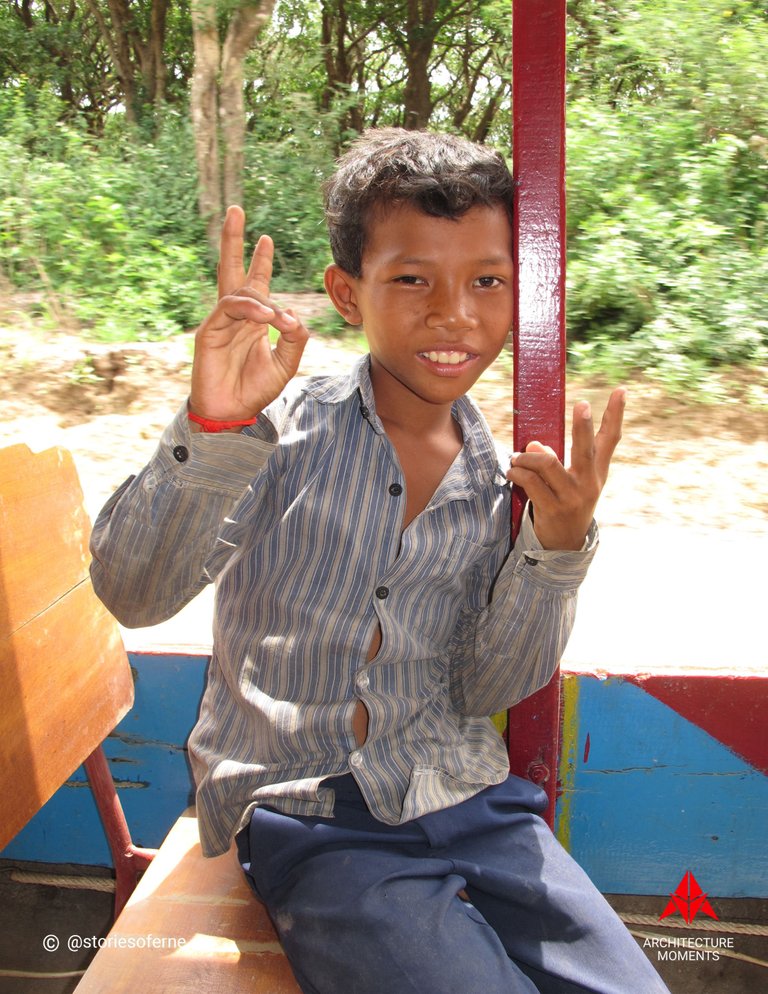
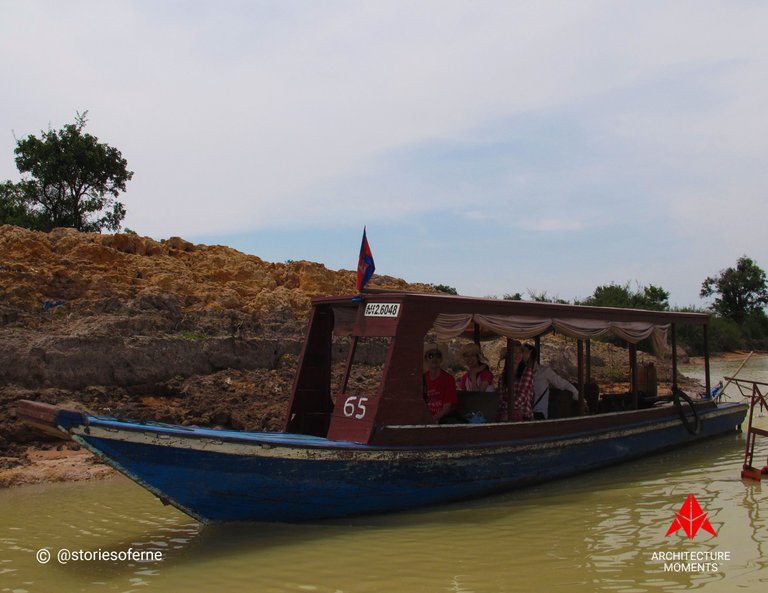
We even encountered other foreign tourists along the way. I didn't hesitate to wave at them, and in return, they also raised their hands and gave me big smiles. Zoom in on the picture for a clearer view.
Stilt Architecture of the Floating Villages
And now for the crème de la crème. I'd definitely consider this floating village as the main highlight for this journey. Here, I got the tremendous opportunity of observing, enjoying, and documenting on photographs an unparalleled architectural habitat that had, for several decades, adapted to the powerful forces of nature, most especially, the ever-changing aquatic environment of Tone Sap Lake.
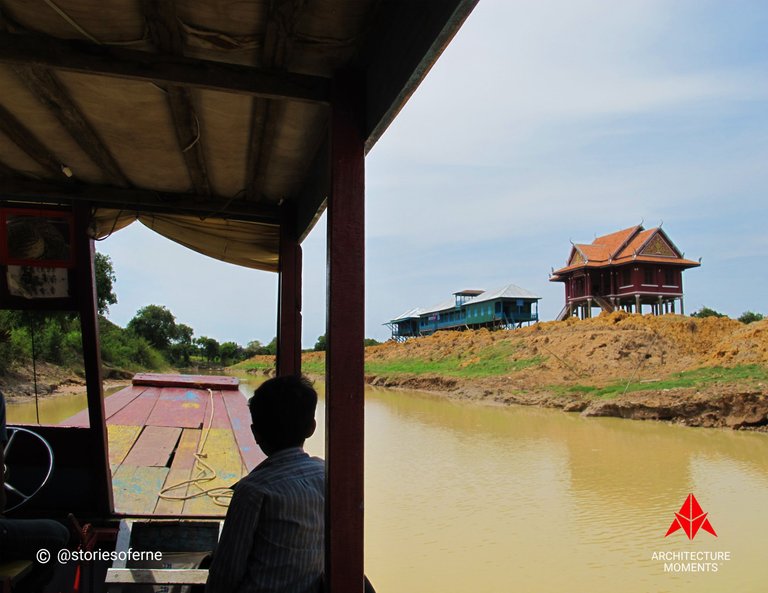
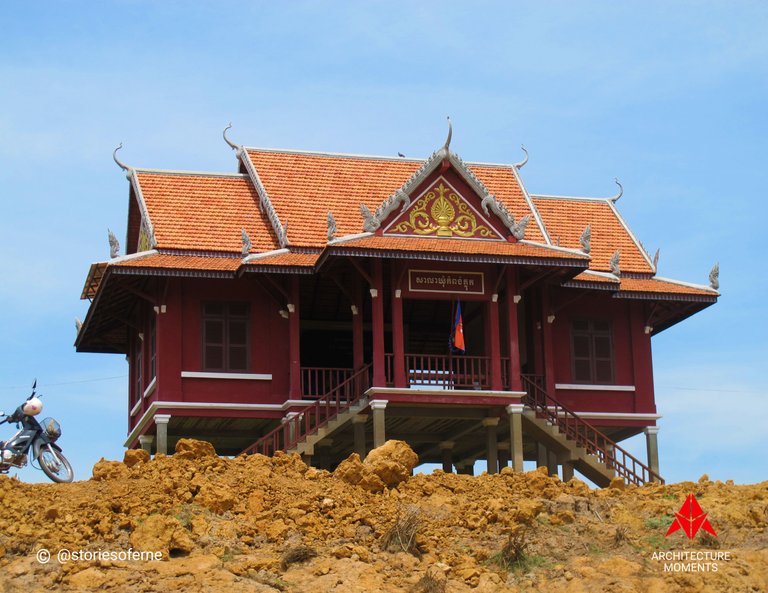
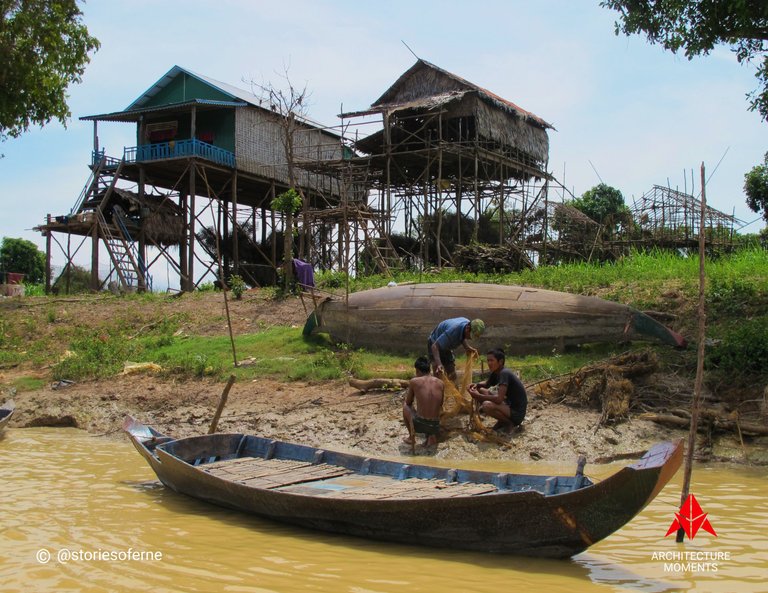
I truly felt a sense of accomplishment during those moments because experiences like these don't happen often. It would definitely be a regrettable decision if I didn't agree in the first place to visit a place where traditional Cambodian architecture was evident for avid fans to witness.
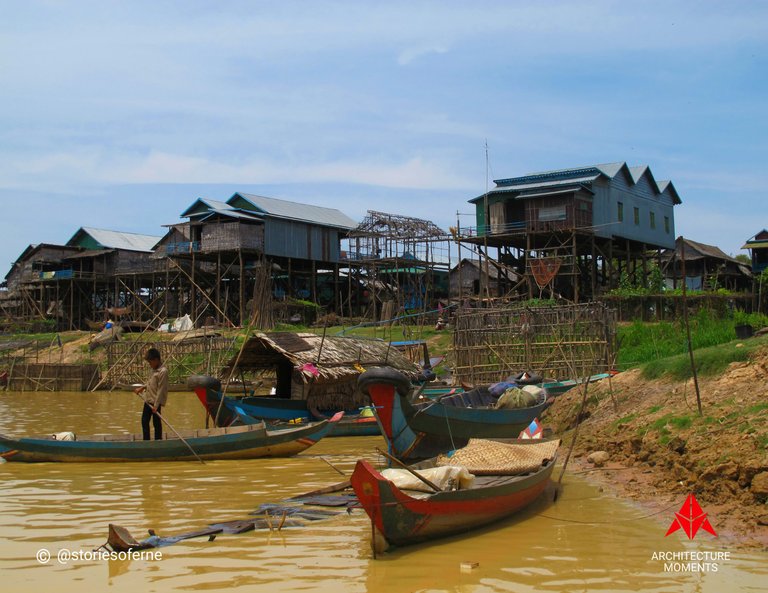
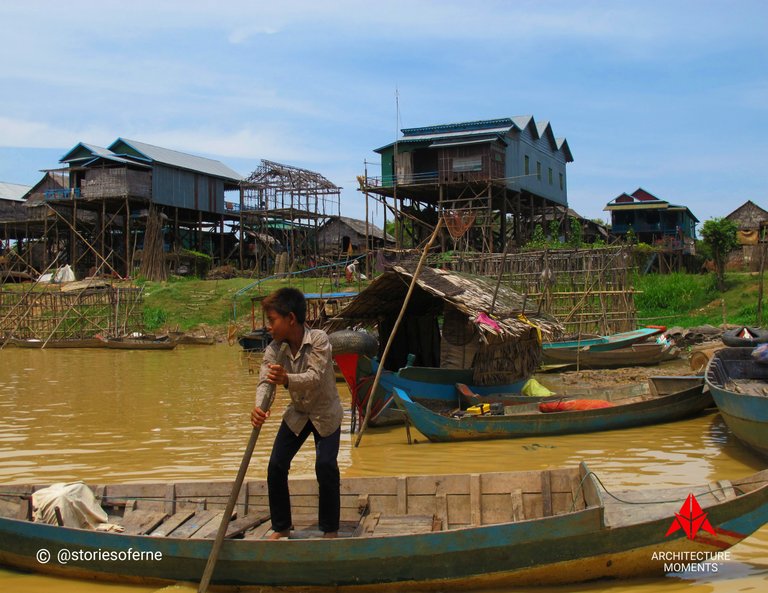
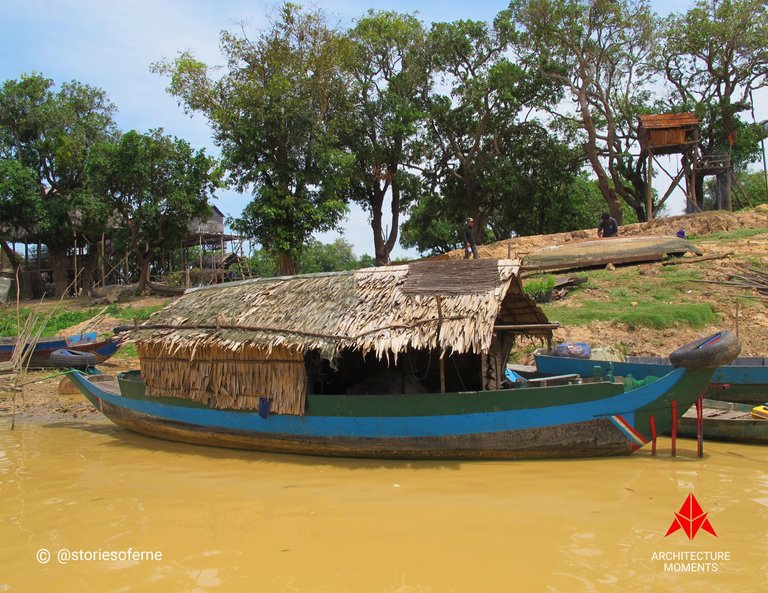
There was an abundance of these types of floating villages, and they were scattered on different spots on the lake. And it was said that millions of settlers and villagers had made this environment their abode, plus a source of food, water, and other resources for their livelihood.
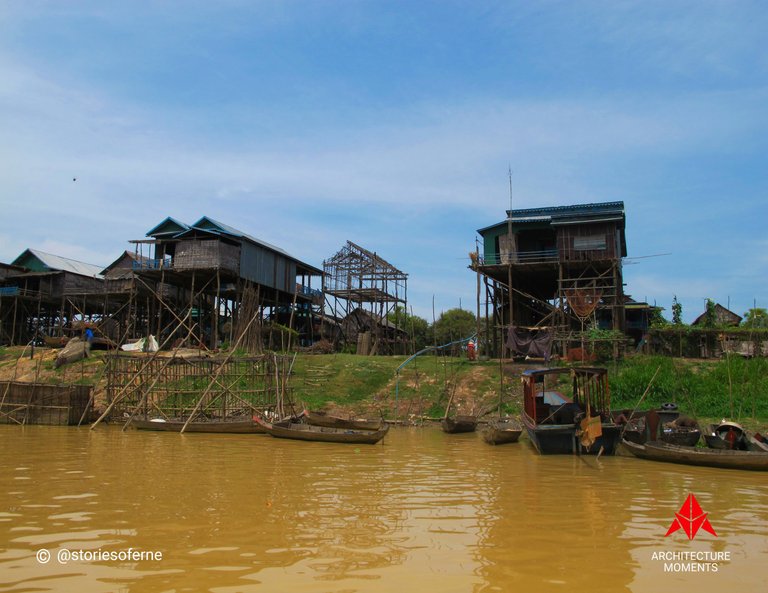
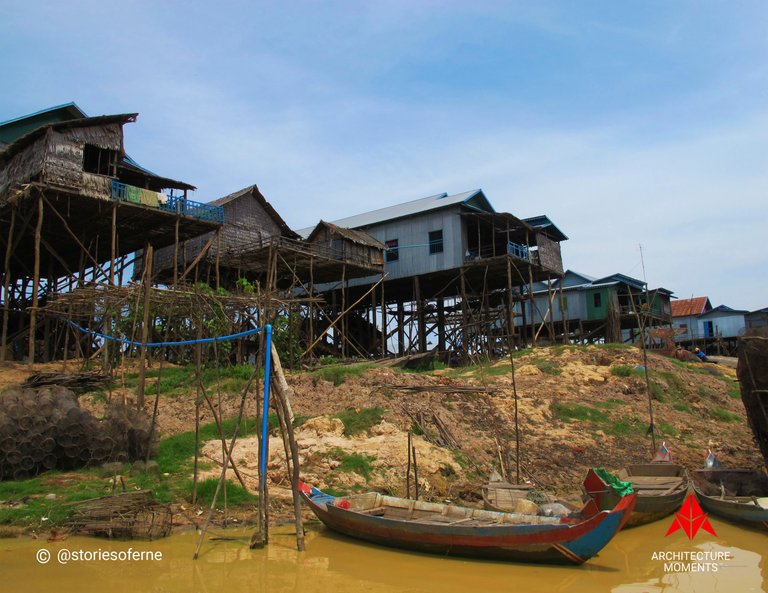
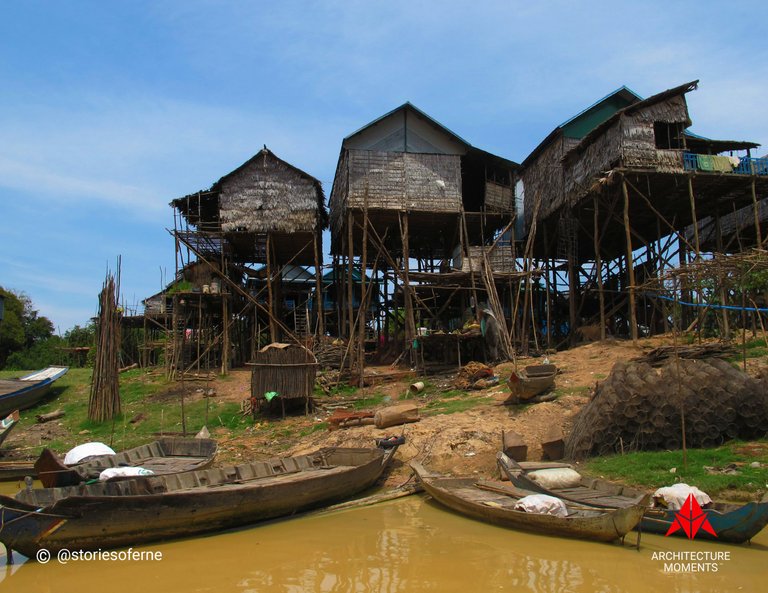
An immense number of these distinctive structures were constructed on stilts, thus elevating them far away from the ground level. These long vertical poles or piles become more evident during the dry season (December to April) when most of the lake's water disappeared or receded. I happened to be there during the wet climate (May to November) where most of the water was present.
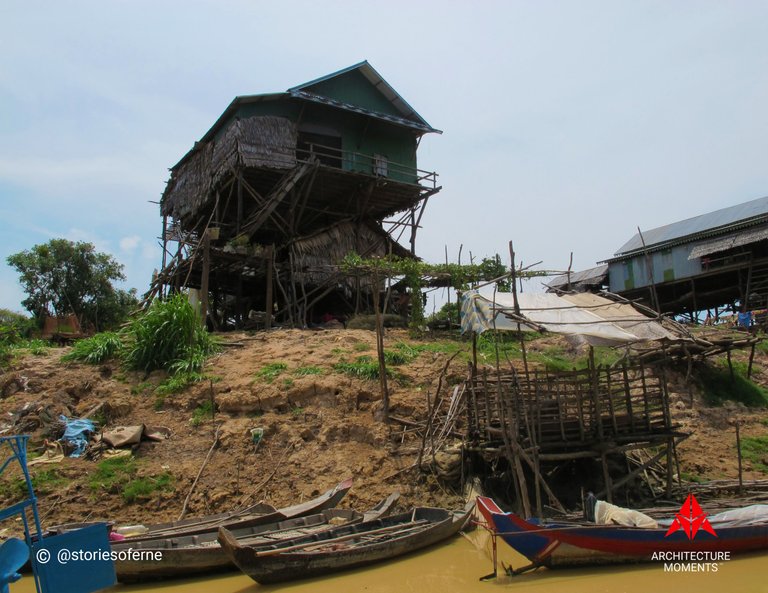
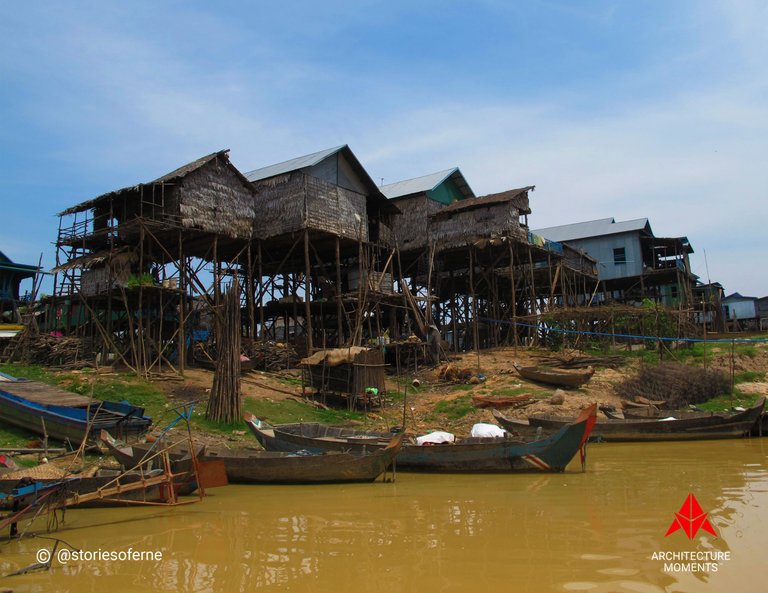
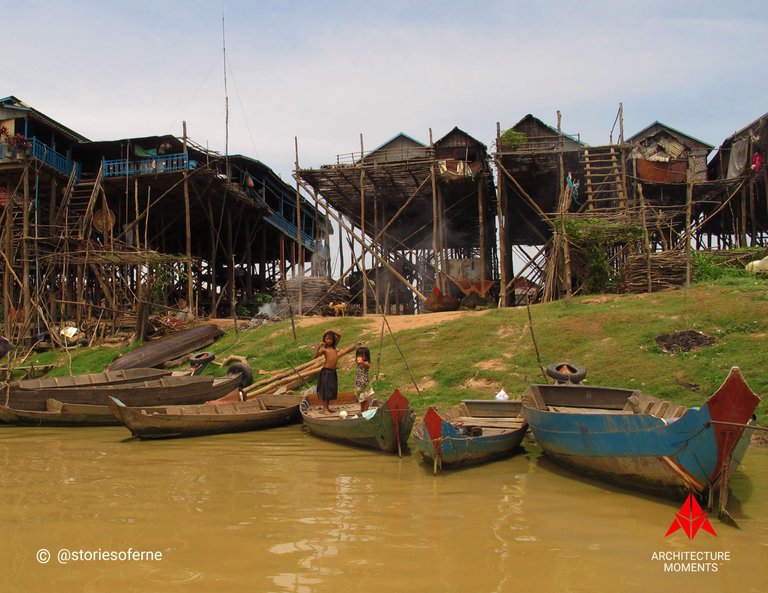
Here's some interesting data. It was alleged that most of the lake's inhabitants were of Vietnamese origins, in particular the villagers who resided in houseboats and floating platforms. Although most of these people were born and raised in Cambodia, they didn't possess the legal documents to exercise their adopted country's citizenship rights. Thus, they continued thriving off the waters of Tonle Sap Lake to evade government jurisdictions. It was certainly a pitiful sight looking at these poor folks as a large majority of these settlers were on the brink of poverty.
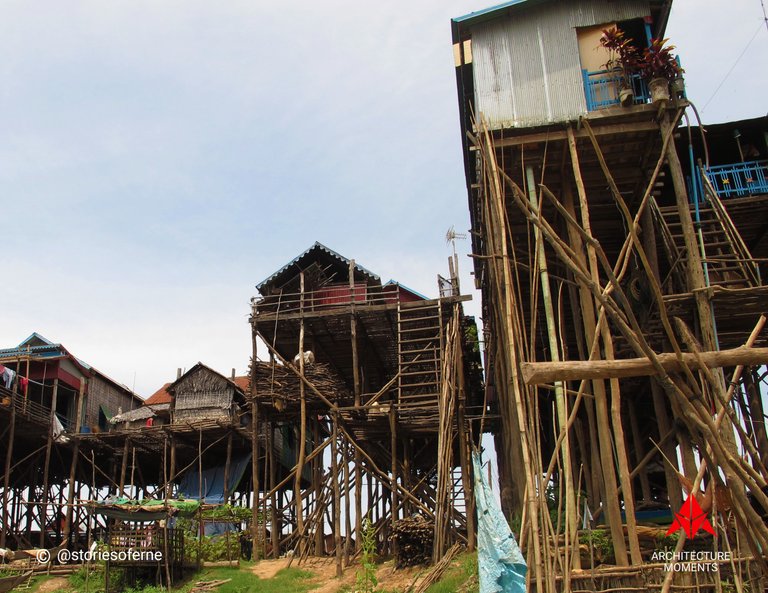
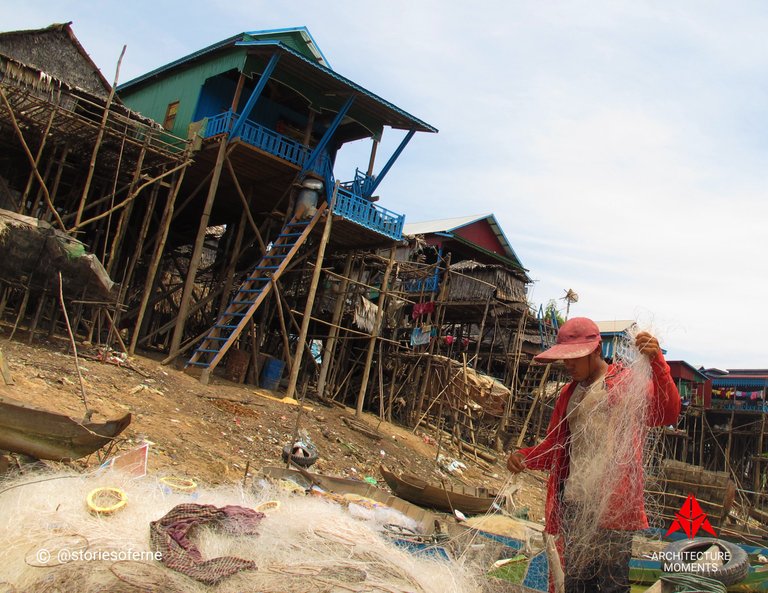
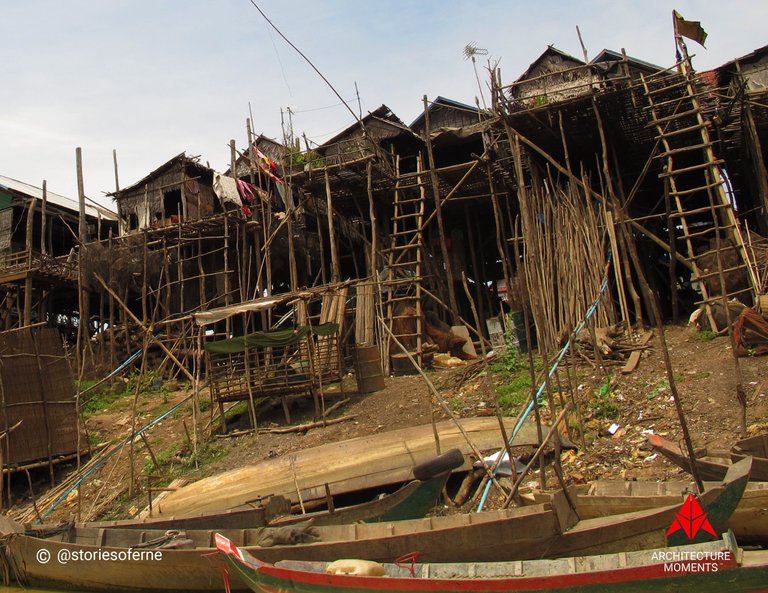
I was also informed by my host that there were four famous floating villages typically explored by tourists, and were categorized according to their physical distances from Siem Reap. These were Chong Kneas, Mechrey, Kompong Phluk, and Kompong Khleang. The favorite one for visitors was Kompong Khleang as this floating village had the most remote location, approximately 60 kilometers away from the urban center.
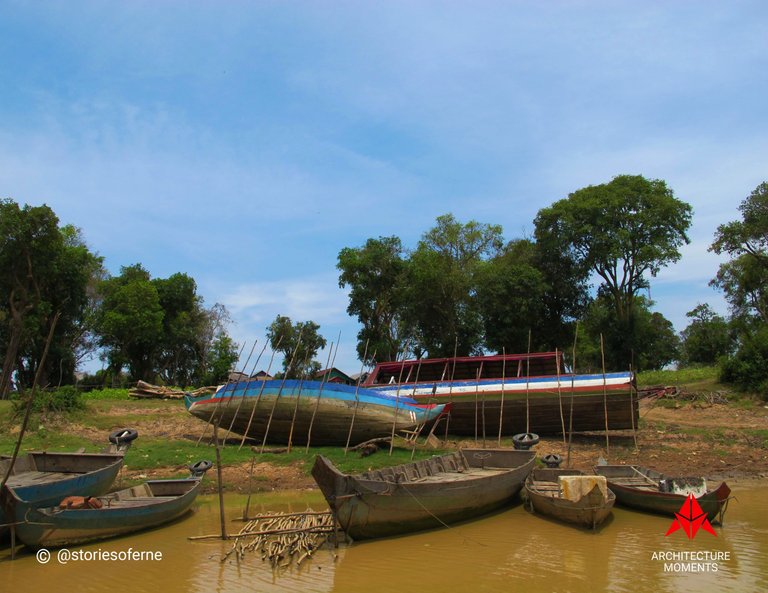
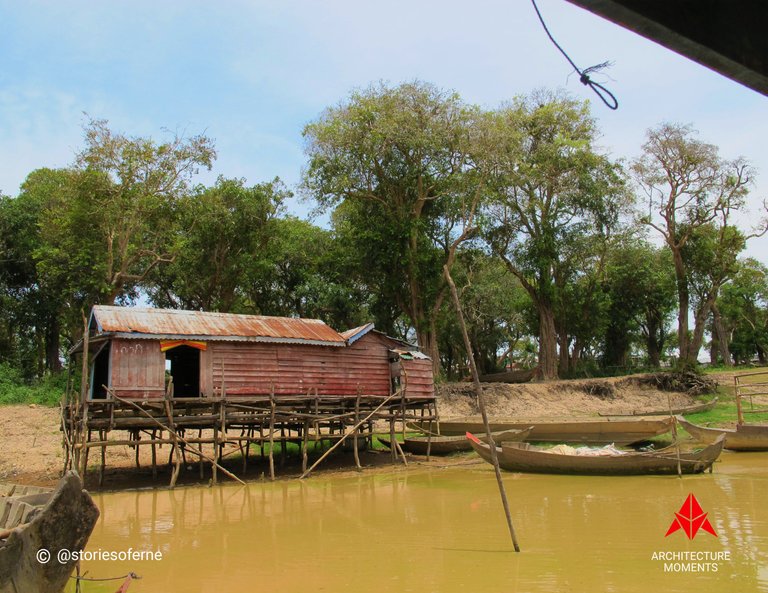
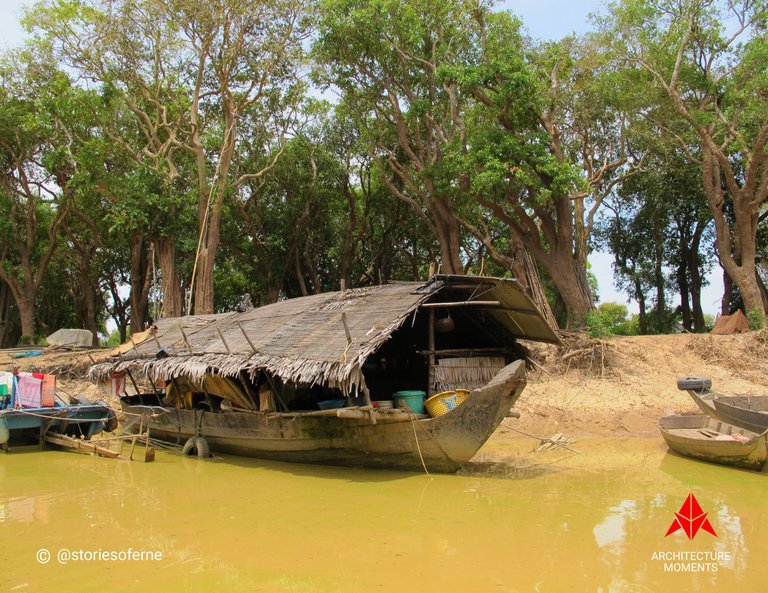
These stilted habitats were constructed along the banks of the narrow water channel, with the roads also traversing beside them. During the wet season of the year, these dusty thoroughfares were deeply flooded and were completely submerged by the waters of Tone Sap Lake. On the other hand, the dry season left the open roads accessible for all types of land vehicles. Isn't that interesting?
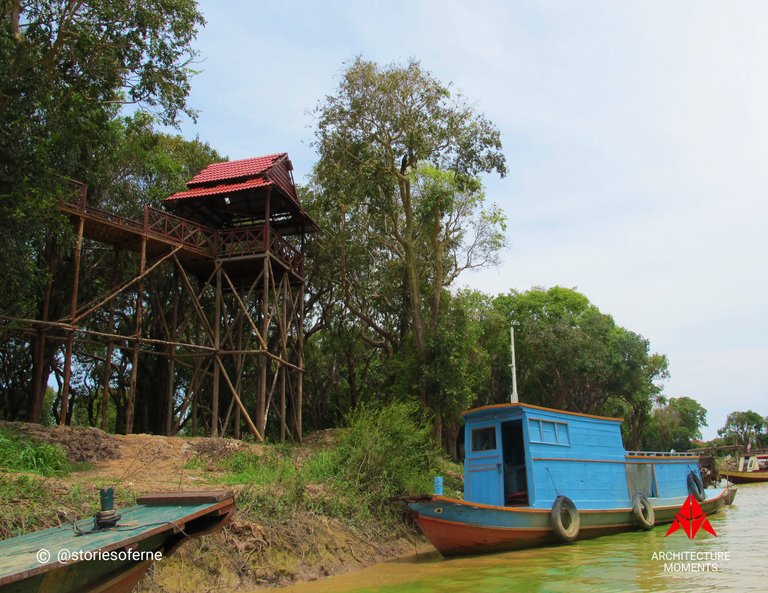
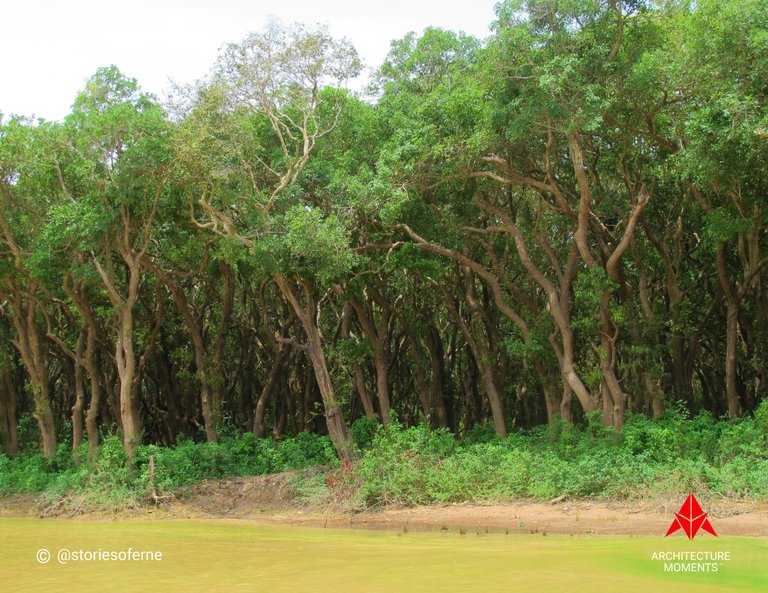
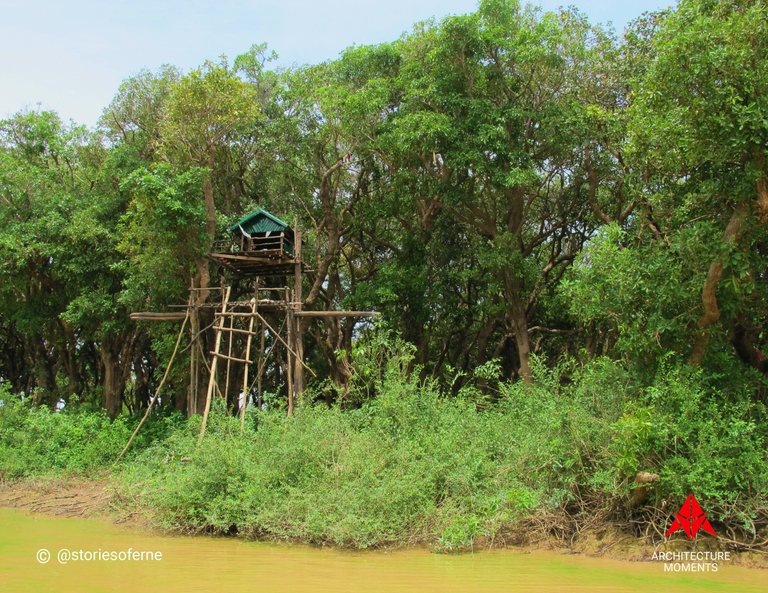
We were now in close proximity to the lake's mouth as I noticed its vastness while also having a glimpse of the water line on the horizon. We were about to enter this region's main body of water. From that location, there were fewer houses on both sides but saw more mangroves, forests, and other plantations surrounding the coastlines of the stream.
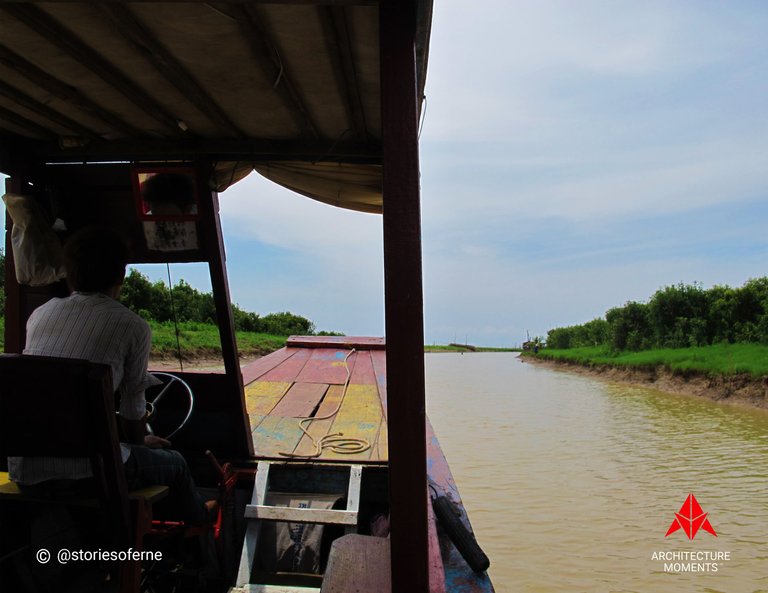
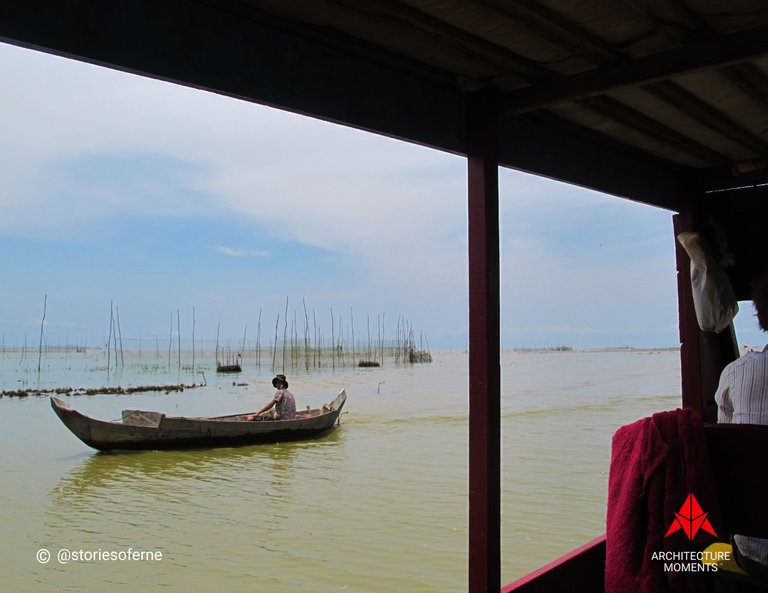
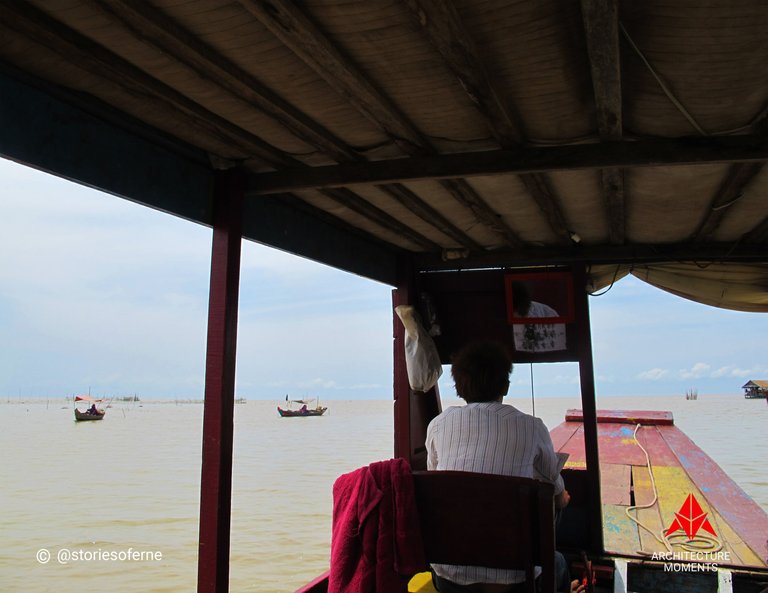
The Tonle Sap Lake, as unassuming as it may have appeared, was officially recognized in 1997 as a UNESCO World Heritage Site, particularly as an ecological hotspot due to its biological diversity. Thus in 2001, it was also declared as the Tonle Sap Biosphere Reserve. It was a massive natural ecosystem where I witnessed several floating platforms on the lake's surface.
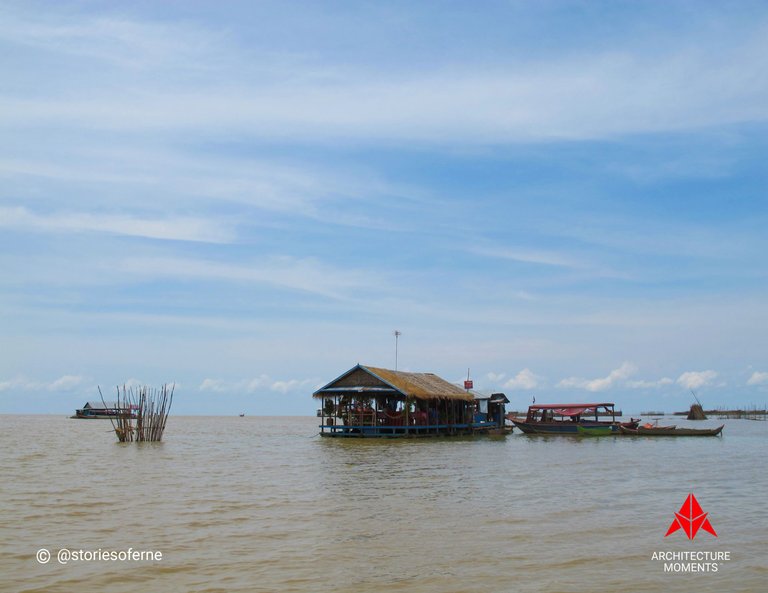
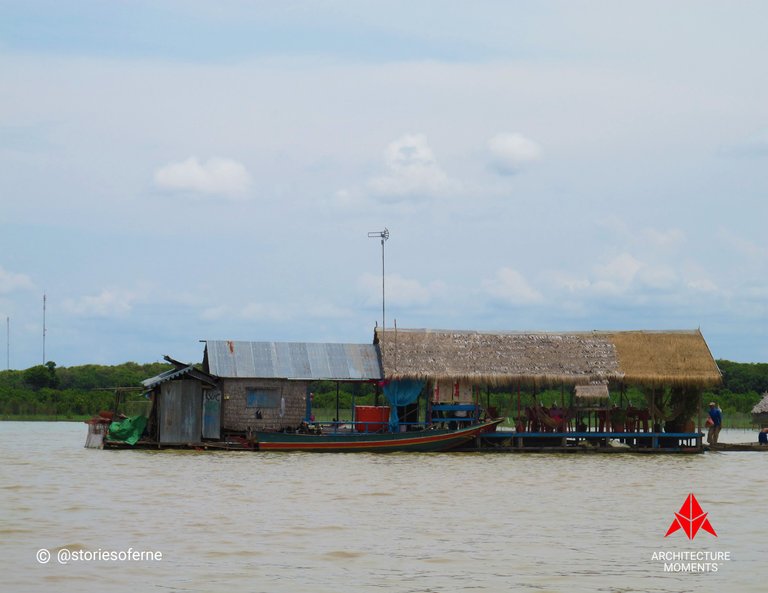
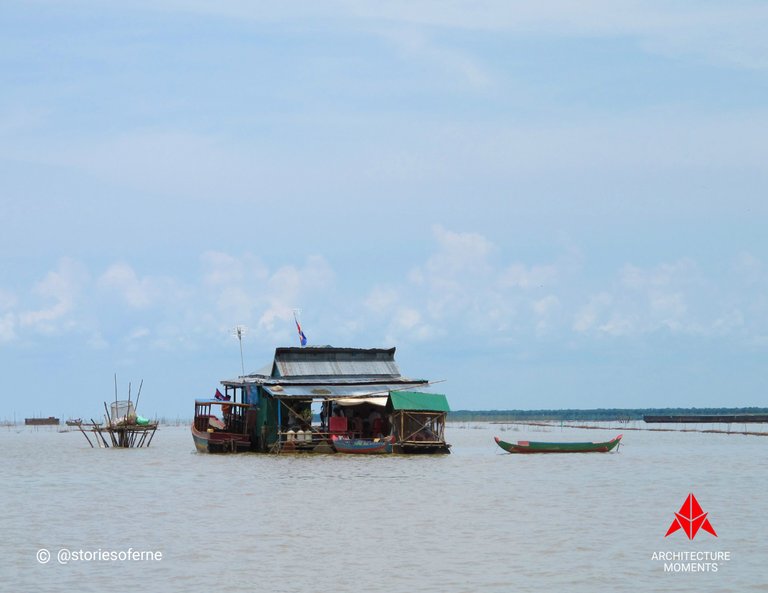
"Hey, what's that strange structure on the left side of that floating house?" I asked my friendly guide as I pointed to the mentioned location. (It would make it easier for you to understand what I'm referring to by zooming closer to the left area of the picture above.)
"Oh, that one? That's a collection point for plastic bottles and other trash. That's one of the most effective ways on how we manage our waste and garbage disposal here on the lake" He said.
"If that's so, the persons responsible are doing a really great job in keeping this natural environment as clean, healthy, and sustainable as possible. Congrats!" I smiled right away after receiving his eager response.
From that point, our boat made a u-turn and headed back to where we came from, entering the lake's mouth once again to pass through our previous passage. This time I had the chance to capture additional photos of other interesting habitats I've missed earlier.
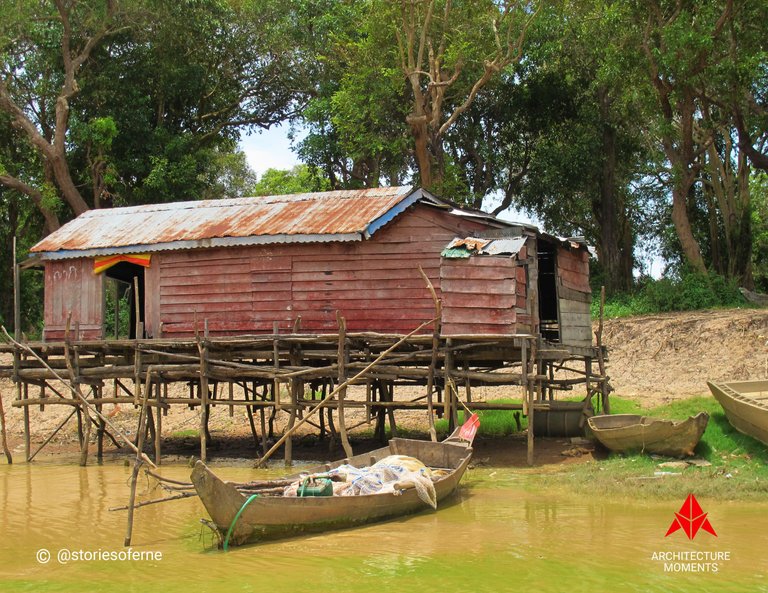
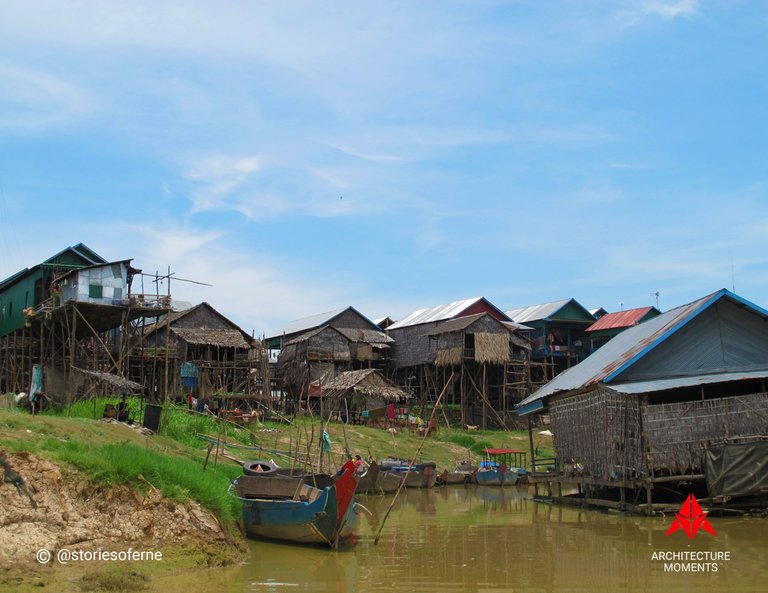
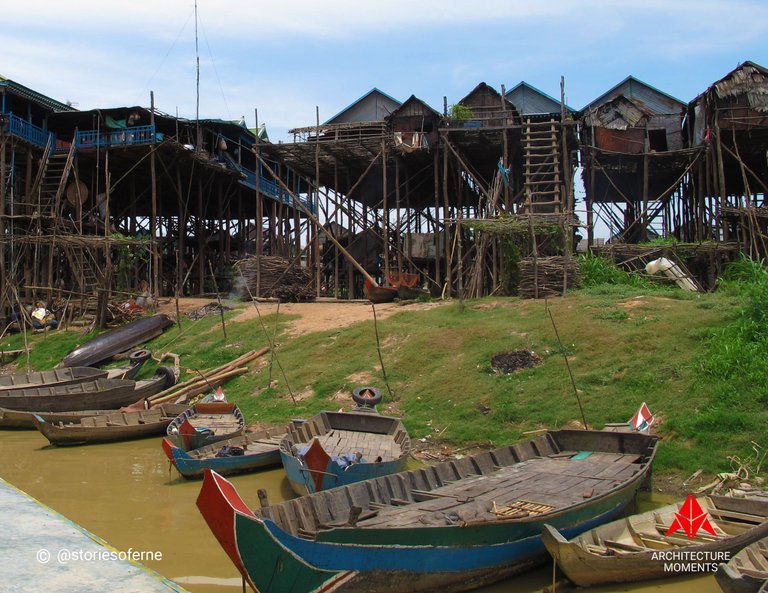
Most of these vernacular homes were typically one-room bamboo or wooden huts erected on gigantic stilts. Like their land-based versions, the upper levels were accessed via long ladders. Some of the elevated floors of these structures stood as high as 6 meters. So, just imagine how far these residents had to climb their ladders just to reach their habitable spaces.
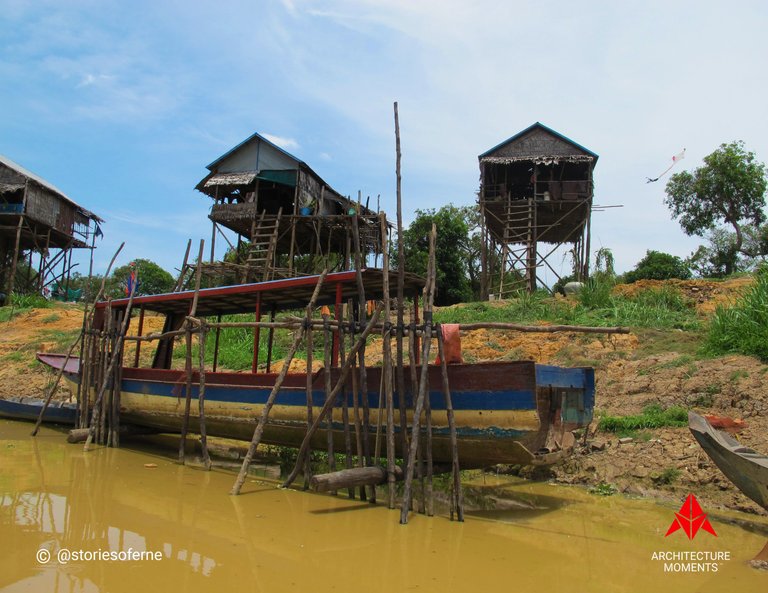
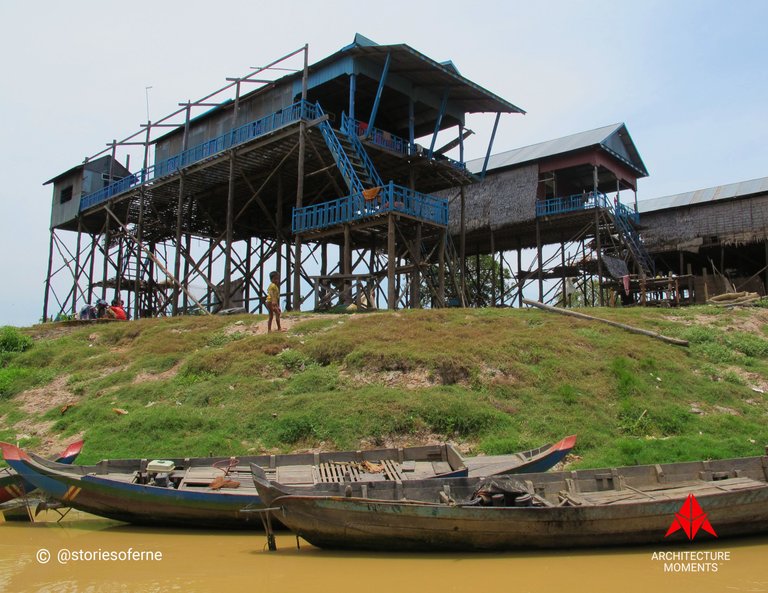
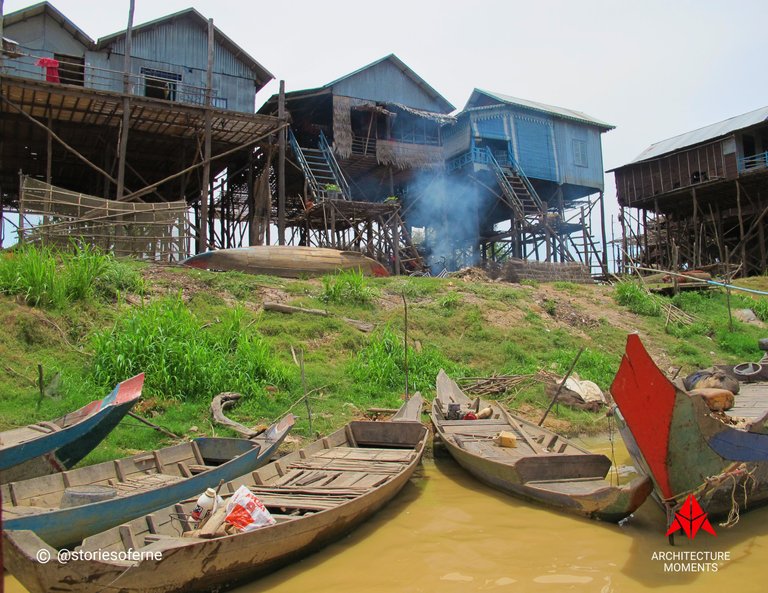
Everyone on these floating villages, except babies and toddlers, had to learn to paddle oars on their boats or canoes from an early age to transport themselves to various locations such as their village commercial shops, medical facilities like clinics, floating markets, entertainment spots, schools, sports venues, and places of religious worship.
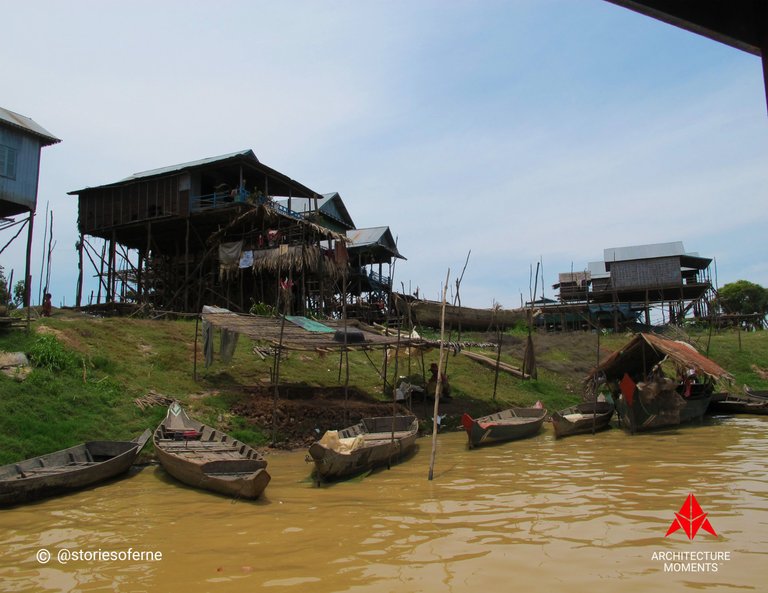
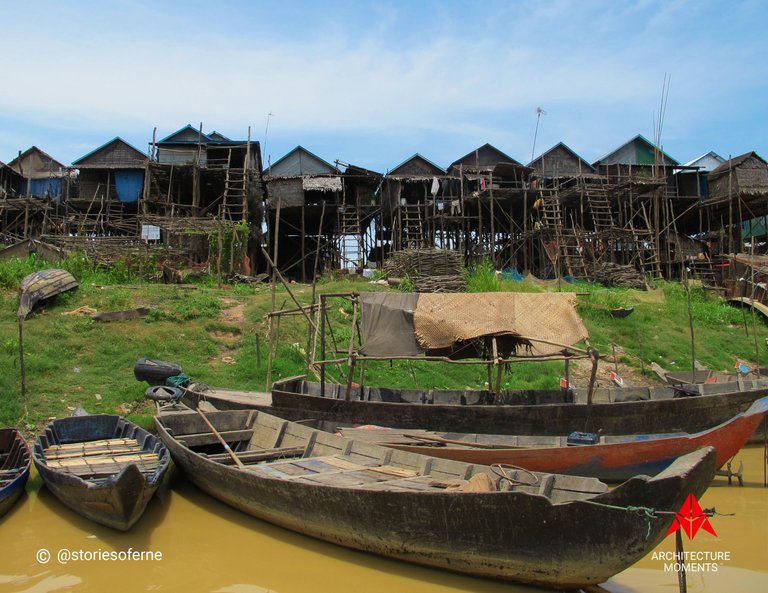
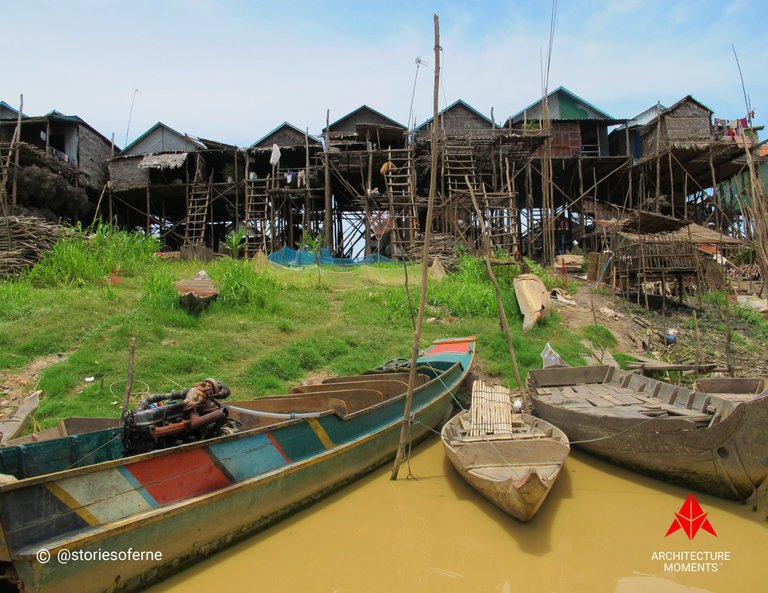
These small communities living on the Tonle Sap Lake basically had two types of habitats built according to their lifestyle: Mobile and Permanent. The mobile houses were the floating platforms you've seen that were also flexible to the changing water levels of the lake while their permanent counterparts were the various coastal structures built on stilts.
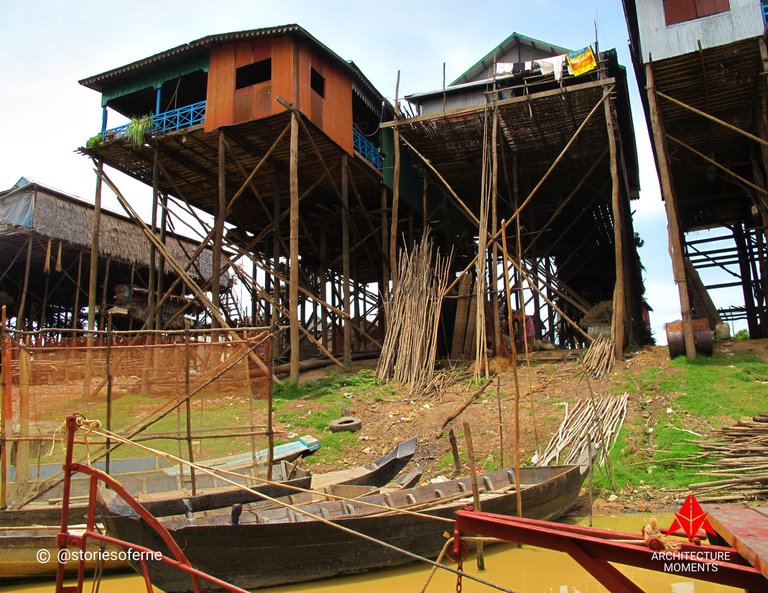
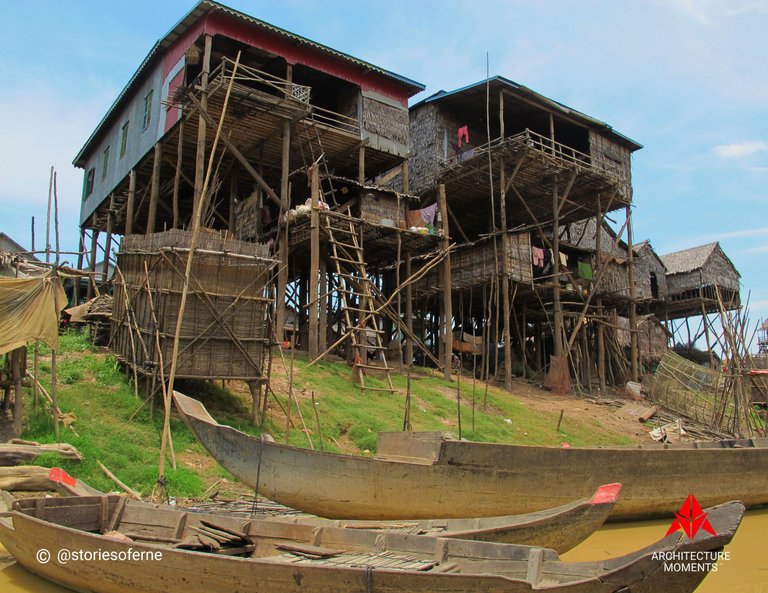
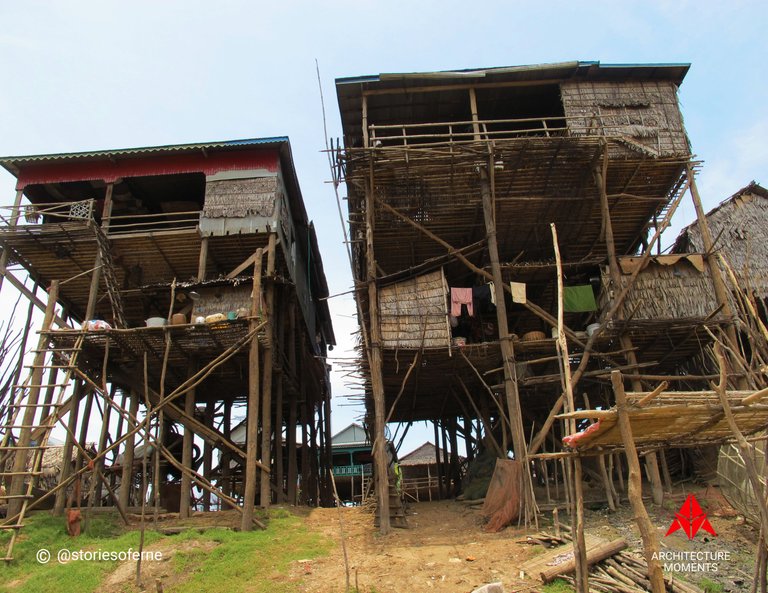
As most of the inhabitants of these floating villages belonged to the lower-income class, they were forced to utilize cheap building materials like wood, corrugated steel, thatch, bamboo, and plastic wrappings for protective purposes. Construction methods employed were simplified and prioritized practicality and efficiency, only using the minimum amount of structural elements to support their lake houses.
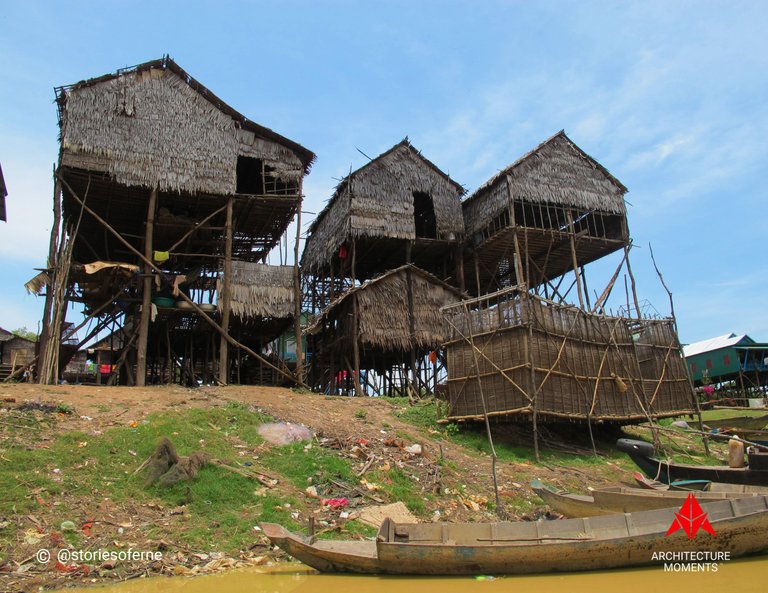
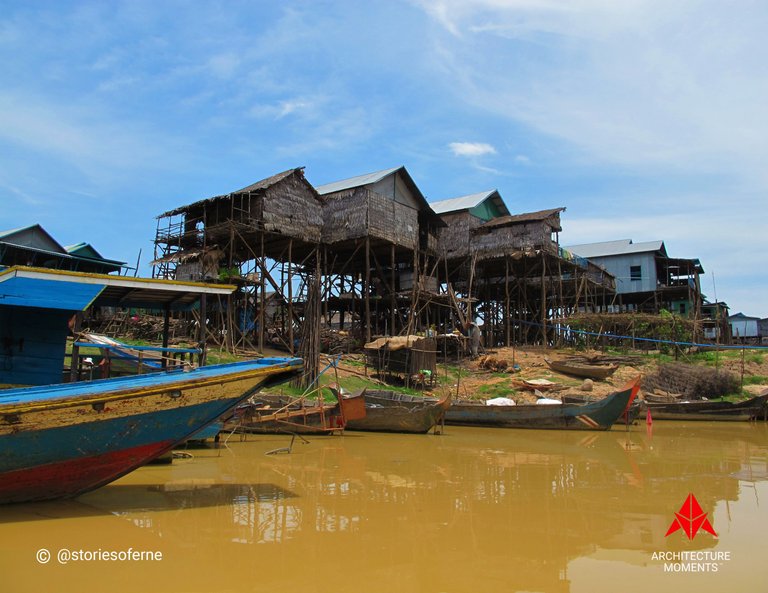
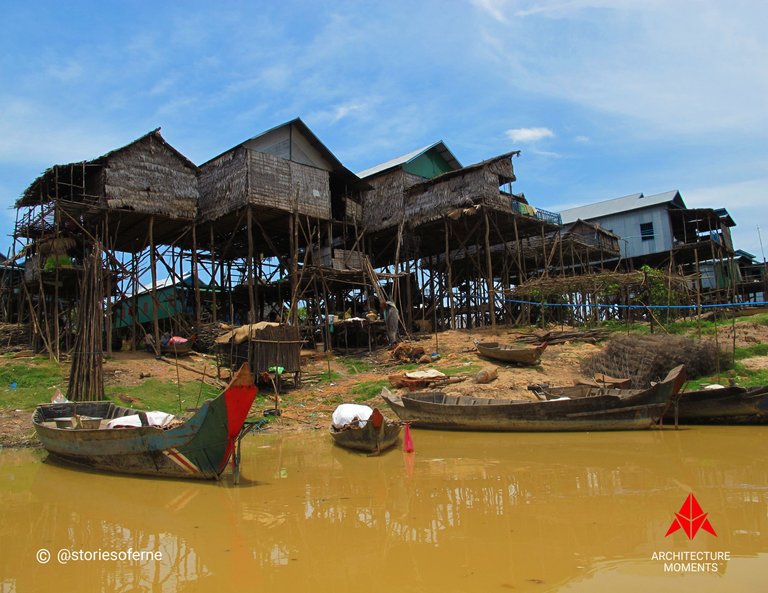
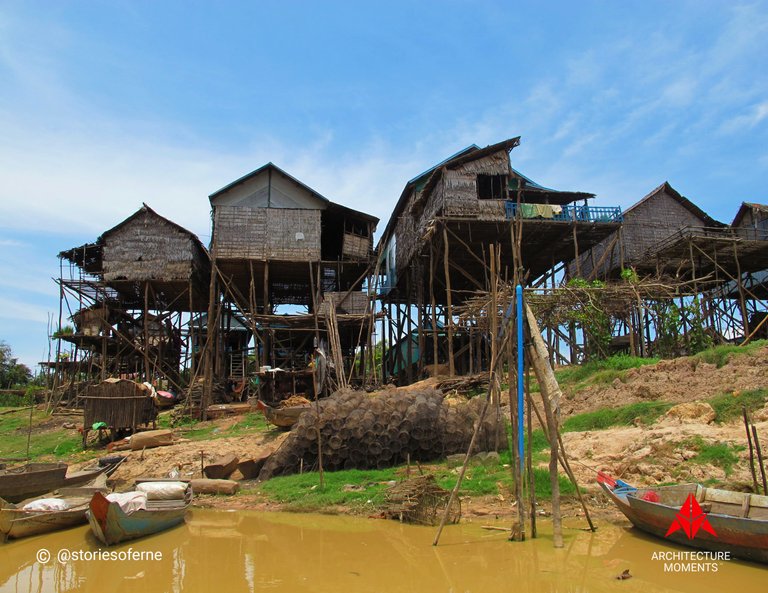
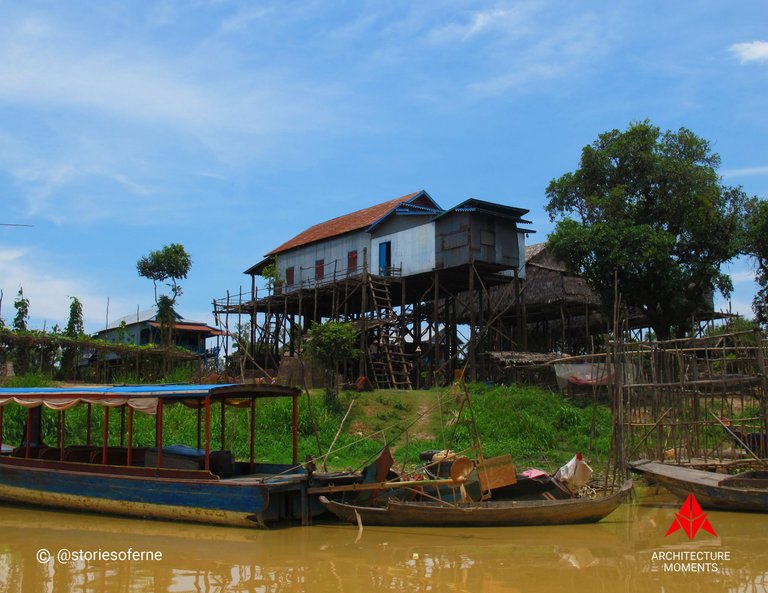
Again, I was deeply fascinated by these landmarks due to the ways they had conformed to change. The worst thing they could have done was to go against the flow of Mother Nature and suffered the consequences afterward. Fortunately, they decided to dance with the evolving times and sustained themselves for the better. From what I've observed so far, these villagers together with their indigenous dwellings had definitely learned to cope up with the flood plains of Tonle Sap Lake for many generations. They had continued to survive by fundamentally designing a remarkable architecture that also adapted to the constantly changing environment.
Shout-out to Marvelous Watercrafts
This specific adventure on Tonle Sap Lake wouldn't have been possible without these amazingly reliable aquatic vehicles. I'm dedicating this special section of my post to honor these extraordinary boats.
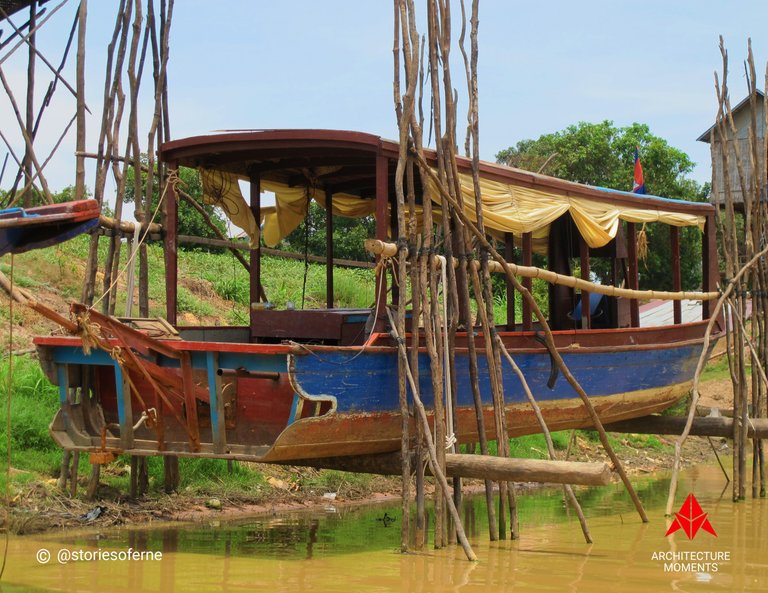
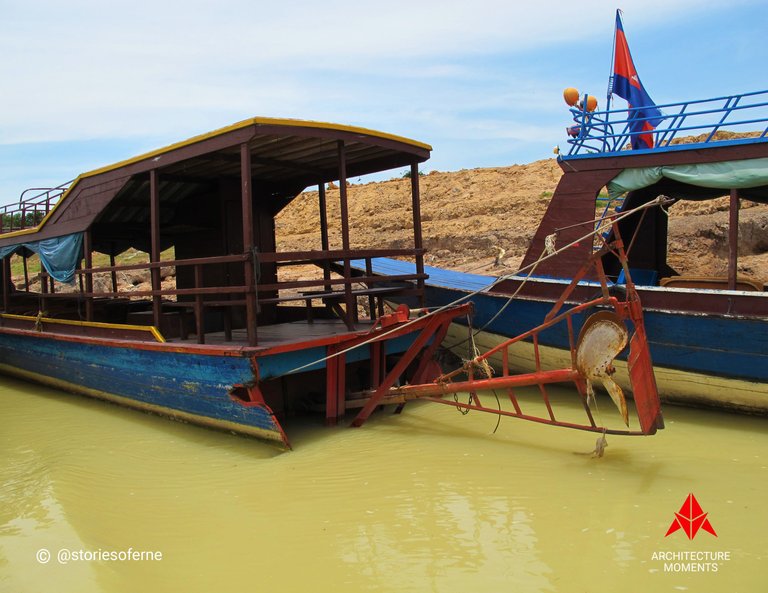
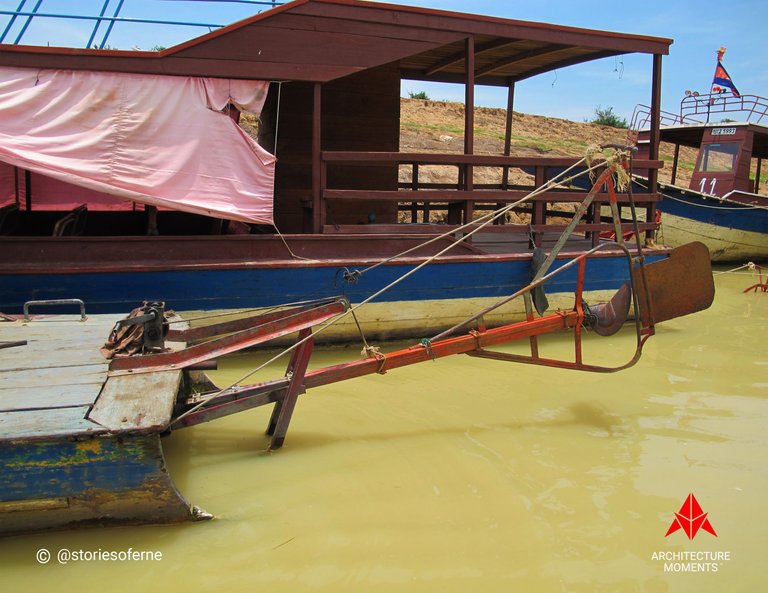
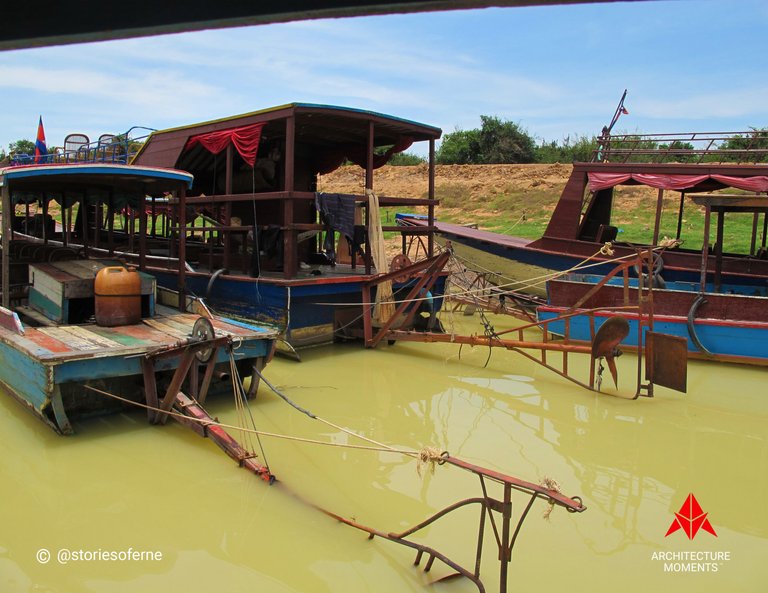
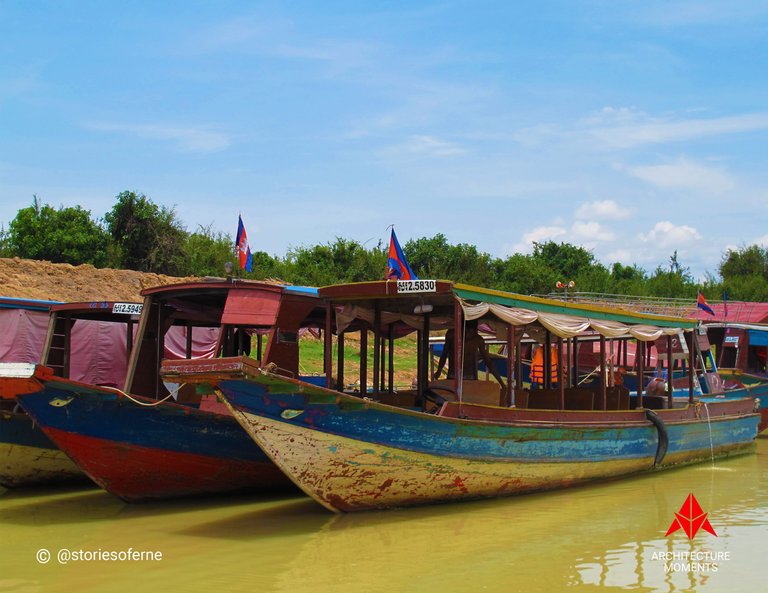
With their sturdy construction, choice of suitable materials, plus their ingenious rudder and propeller systems, they could easily plow through the thickly muddy waters of the floating villages. Most especially during the rainy season of the year when massive floods dominated their neighborhoods, these extremely helpful vessels transported the locals to practically any point in that region. What can you say about these types of marine transportation? Have you tried one of these boats lately?
Rare Experience of a Lifetime
Overflowing with smiles, I was definitely grateful to my tour guide cum Tuk Tuk driver for the unexpectedly magical trip on that day. Initially, I had the impression that I'd be seeing nothing out of the ordinary. Yet, it turned out more than what I'd previously expected due to the plethora of beautiful surprises along the way. Sometimes, you don't need to plan your itineraries in advance to know exactly where you're going. That's understandable, as this may seem like a gamble to risk yourself for regrets later on. It's okay. Most of the time, these escapades would end up becoming truly satisfying. Escaping your comfort zone during these exceptional occurrences is surely captivating. Simply allowing the spontaneous flow of events to catch you off-guard and transporting you to places beyond your wildest imaginations, are worth it.
Would I recommend experiencing the stilt habitats of Cambodia if you dream of traveling to their country someday? Of course, go ahead! You may not be an Architect like me, however genuinely immersing yourself in these spectacular built environments, not only fulfills a design intent but also unlocks an entirely new world. As a result, you would likewise be directly exposed to their authentic traditions, culture, and lifestyles, get to personally mingle with the friendly locals and marvel at other interesting details from a close perspective. Fair enough?
#Hive, what are your thoughts about the rural Khmer houses in the countryside? What about the stilt dwellings or floating platforms on the lake? Aren't they fascinating? Let's talk about them in the comments.


Hello friend Erne @storiesoferne I greet you from Venezuela. Excellent storytelling, excellent photographs, and excellent publication. Congratulations; In addition, I thank you for taking us to Cambodia on your tourist trip, Thank you for taking us to know the Tonle Sap Lake and for showing the ancestral architecture of the stilt houses, houses built in an ingenious way and with a lot of cultural roots, fresh and safe. In Venezuela, specifically in Lake Maracaibo, Zulia State, we have this type of housing that show the human past and the traditional present of millenary cultures that survive amid vicissitudes. Receive a strong spiritual hug full of blessings, positive energy and lots of light.
Little Venice some months ago in our beloved community about the Palafitos, which is Venezuela's version of floating villages. These magnificent coastal houses are considered to be your country's most ancient type of ecological habitat originally constructed by the Aborigines. Thank you very much for your marvelous insights. Stay healthy always, and receive more blessings! 😊Hello, my friend Marcos @marcosmilano71. It's my great pleasure to virtually transport you to Cambodia and experience their stilt architecture. I remember you also published an epic post called
Hello dear friend Erne, @storiesoferne. Yes, you're right, Little Venice, a world of stilt houses where the name Venezuela is presumed to be derived. Thanks for remembering that post. I congratulate you for your excellent work and I thank you for your constant contribution to the community, thank you also for your support and for your valuable friendship. Receive a strong and warm spiritual hug full of blessings, positive energy and lots of light.
Khmer Houses of Cambodia truly posses the historic rural quality and are for sure worth visiting. Thanks for giving us a virtual tour. It was very informational.
Stay awesome and keep flourishing ;DGreetings @storiesoferne, what an educational voyage. AS I was reading through, was just wondering why is stilt necessary? but as you answered giving three potential reasons I was sorted there. Your commercial break made me smile for real. Also Loved that little kid and how he instantly posed for the picture.
Greetings @praditya. I'm so grateful to you for comprehensively digesting my post to the last detail. And particularly on how that commercial break injected some splash of humor into your day. All in all, it was truly a magical experience. And perhaps some of my words might not be enough to express the real splendor of that place however, the architectural journey was definitely worth it. Also glad that you've learned plenty of insights from my post.
Most importantly, I'd like to take this opportunity to congratulate your country of India for winning Miss Universe 2021! This spectacular news was just announced recently. Time to celebrate, cheers! 😊
We are super happy for miss universe pageant. Thanks for the wishes on behalf of my country. You are such a generous man.
Stay blessed 😊😊😊
You're most welcome. Best wishes and more blessings! 😊
The stilt houses are truly mesmerising as they posses so many features moreover they are built by local people which shows how genius people are over there.
Thanks for the virtual tour of Cambodia, wishing you a beautiful week ahead.Hey dear @storiesoferne, what an beautiful experience it is always cherishing to travel and connect with people from different walks of life. I am amazed at how the waste of the lake was managed that was a great job over there. The foreigners visiting the village must be so good for economy of the village .
Hey dear Sahiba @sahiba-rana. Thank you so much for taking the time to digest this architectural story of Cambodia. Because of the Tonle Sap Lake's significant contribution to the locals as a natural resource, it's an immense relief that they've also done their part in nurturing the environment by managing their garbage disposal systems well. This vital evidence of authentic care for their surroundings definitely made me smile during my visit. Despite the simplicity of their vernacular architecture, there were plenty of valuable lessons learned that simply made a sustainable impact on their culture, lifestyle, and tourism industry.
Having said that, it's always a huge delight to share my architectural adventures around the world for the education, awareness, and entertainment of loyal enthusiasts. I'm also extremely grateful to you for sticking around and contributing your share of fabulous content. Have an awesome week and take care always. 😊
Indeed when humans pays back to the nature by just cleaning or taking care of it is amazing. many people lack such basic understanding. I am happy to find out that people over there are not just skilled in stilt housing creation but also owe a sense of gratefulness towards nature and takes care of
its cleanliness. Nature surely gonna reward them with much more resources.
Thanks once again for sharing your experiences. Stay blessed:D
Indeed dear Sahiba. What we give to the universe will always come back to us. Therefore, by nurturing Mother Nature, we likewise end up taking care of ourselves. You have a kind heart. And I'm definitely moved by your powerful words. Receive an abundance of blessings and the best of what life can offer. Always. 😊
What an exceptional experience to visit these remote places. Absolutely love the different stilt design, foresight and necessity, also depicting difference between lower and higher income groups but the look of roofs in design.
Also love nature so glad you have added some of the way of life in this region!
@tipu curate
Upvoted 👌 (Mana: 33/93) Liquid rewards.
Yes, it truly was. Sometimes, non-touristic spots in a destination satisfy you with a different kind of experience, way better than the usual activities offered in normal tour itineraries. Immersing in their vernacular architecture was a one-of-a-kind adventure, and I was glad this happened to me. 😊
'Robinson Crusoe' type of life, very small but practical, off the ground for many safety reasons. Always interesting to see how people live in dwellings like that. Most off the beaten track events are most rewarding.
The settlers of these floating villages certainly have conformed to this way of life for many generations. Though most of them have struggled on the poverty threshold, they've learned to go with the flow of Mother Nature. As a result, their stilt architecture is definitely a tremendous testament to that. And it was truly fortunate for me to have witnessed their admirable culture in person. As always, many thanks for your kind generosity and sincere appreciation. Cheers! 😊
Arranging your own last minute drive you more than likely saw more than most, meeting with locals.
great pictures! i am curious as to how they replace the stilts after they start to rot!
Oh yes, these stilts do eventually need to be replaced once they have deteriorated. From an architectural sense, additional vertical supports or scaffoldings must be temporarily installed close by while replacing damaged stilts. Thank you for your appreciation. 😀
Friend @storiesoferne your publication has impacted me, for the nourished in images and excellent narration with which I have made a trip with you to Cambodia. The traditional houses on stilts and boats on the Tonle Sap Lake has been magnificent, because each culture has its charm. In my country, specifically in Zulia State you can see houses on stilts, called palafitos of the ethnic groups living on the shores of Lake Maracaibo, as mentioned by our dear friend @marcosmilano71. These dwellings are maintained by ancestral traditions. Blessings and a happy week ahead.
Hello, friend @sorprendente. It brings me great delight to know that you've sincerely enjoyed this publication, Like the stilt houses featured here, the Palafitos of Venezuela is indeed a cultural trademark, a remarkable architectural heritage of a special breed of people who brought their ancient construction techniques to be admired until our current generations. Enjoy life and have a productive week. 😊
Yes my friend, the Warao and Wayúu ethnic groups are the ones that receive the most credit for this very admirable water architecture in Venezuela. The ancestors of all cultures never cease to amaze and influence today, where we still see how some traditions survive, as is also the case in Cambodia. Cheers my friend 😊
Many thanks for the additional knowledge. It truly helps to offer credit and honor the original creators of our ancient architecture. Without them, we couldn't have experienced what we're benefiting from today. Stay safe and best wishes friend. 😊
Wow! This fascinating world of a different culture and styles of houses than in my country. It's always so greatfull to look! Tuk Tuk cars are very attractive, I would like to ride it. These tall buildings above the ground, perhaps so as not to climb snakes? Thanks for sharing @storiesoferne :)
Hello @olga.maslievich. I'm truly delighted to see you again here. Oh absolutely. Cambodia's stilt architecture, Tuk Tuk rides, and everything in between had a tremendous impact on me. It was one of my best travel experiences ever. Don't worry, it would take time for the snakes to reach the upper levels of those elevated houses I think, haha. 🤣 So no need to worry since they were all safe. Glad to have shared my architectural story for you to enjoy. 😊
Very nice photos of structures and landscape . Natural art of designing houses. Nice explanation about your travel experience.
Hello Erne, You writing very nicely very understandeble, good explaining. l am enjoying it and exploring my knowledge.
Extremely grateful to you @hindavi for your inspiring feedback. Stay tuned for more interesting stories, educational articles, and other relevant content for your personal growth and development. Best wishes. 😊
Hello @hindavi. Thank you so much for your words of appreciation. Glad you enjoyed my publication. 😊
Thank you for sharing this amazing post on HIVE!
non-profit curation initiative!Your content got selected by our fellow curator @priyanarc & you just received a little thank you via an upvote from our
You will be featured in one of our recurring curation compilations and on our pinterest boards! Both are aiming to offer you a stage to widen your audience within and outside of the DIY scene of hive.
Join the official DIYHub community on HIVE and show us more of your amazing work and feel free to connect with us and other DIYers via our discord server: https://discord.gg/mY5uCfQ !
If you want to support our goal to motivate other DIY/art/music/homesteading/... creators just delegate to us and earn 100% of your curation rewards!
Stay creative & hive on!
Many thanks, @priyanarc and @diyhub for the continuous support. 😀
Wow those homes are so neat and interesting. Some of them look a little precarious, like a large house built on twigs. It looks like a strong wind could topple them over. Obviously they are built with strong enough materials so that won't happen though. The function of the house being on stilts is pretty interesting too and smart.
Exactly. These Cambodian habitats truly attract your attention and curiosity as they did to me during my visit there. Like you, I had the same initial impression when observing some houses that seemed to be structurally unstable due to their flimsy stilts. Yet. these houses have proven themselves to be stable and have actually survived for many years in that harsh environment.
Greetings @storiesoferne, superb storytelling as always (which makes me glued to my screen while reading your blogs). The stories of the stilt houses as to why they are built are so interesting. The stilts also give a unique beauty to the structure.
This makes me want to also visit the place.
This is interesting information, I never knew this before until you mentioned it here in your blog.
Warm greetings @afterglow. It's always an enormous pleasure to share interesting stories about the world of architecture and design with you and the rest of the Hive. Indeed, these stilt houses of Cambodia are fascinating subjects to learn about and would definitely entice passionate enthusiasts like yourself. Thank you very much for your sincere appreciation and faithful patronage. Until our next exciting topic, have an awesome weekend! 😊
You're always welcome @storiesoferne and I am excited about your next blog.
Always grateful @afterglow for your valuable support. Stay safe and have fun always. 😊
An interesting trip, where leaving aside the rigors of the heat, which can sometimes be inconvenient for the traveler, you show us some habitats and modus vivendi, which could be said to be direct heirs of the most remote past. Despite its apparent simplicity, I imagine that they must also be extremely comfortable and fulfill a function of perfect insulator in that climate. A truly interesting entry and description. Kind regards
Hello @juancar347. Indeed, these primitive dwellings may have lacked modern sophistication but have surely served their true purpose in the context of sustainability in challenging aquatic environments like the Tonle Sap Lake. Despite their crude methods of construction, these ethnic houses are extremely well-ventilated, stable, and functional. Definitely delighted to have observed their modus vivendi at close range, I can tell you that it was one of the best cultural immersions I've ever had. Many thanks for sharing your insightful ideas. Happy weekend! 😊
What a great place ! The houses remind me of a type of construction here in Venezuela, specifically in Lake Maracaibo, Zulia state, where there is a large community of houses on the water, here this type of housing is known as Palafitos.
post published earlier this year. Grateful for your beautiful remark. Cheers. 😊Thanks a lot, @wilfredocav. Certainly, Venezuela has her own interesting counterpart of stilt houses as likewise discussed by our dear friend @marcosmilano71 in his awesome
Tremendous publication! Beautiful Landscapes.
Many thanks, @jhonnygo. Truly appreciate your beautiful compliment! 😊
Daily Travel Digest #1407.
Become part of our travel community:
- Join our Discord
- Learn more about our travel application
Hiya, @ybanezkim26 here, just swinging by to let you know that this post made it into our Honorable Mentions in Your post has been manually curated by the @pinmapple team. If you like what we're doing, please drop by to check out all the rest of today's great posts and consider supporting other authors like yourself and us so we can keep the project going!Thanks, @ybanezkim26 and @pinmapple for the appreciation and support. More power! 😊
Congratulations, your post has been added to Pinmapple! 🎉🥳🍍
Did you know you have your own profile map?
And every post has their own map too!
Want to have your post on the map too?
The rewards earned on this comment will go directly to the person sharing the post on Twitter as long as they are registered with @poshtoken. Sign up at https://hiveposh.com.
My friend I sincerely wish you a Merry Christmas with your loved ones. A big hug!
Hello, my friend @xandra79. Sorry for the late response as we had to deal with a devastating super typhoon last year. We're currently striving to get back on our feet for all things to be back to normal. Belated Merry Christmas to you and your lovely family! 😊
How nice to know about you. I had an intuition that something had happened because you are very interactive and had not responded. I am sorry you went through that terrible typhoon. I send you my best energies and pray to God that normalcy returns to your home and your region. Thank you for your good wishes for me and my family. Amen! God bless you! A big hug!
Really happy to be back here dear @xandra79 and I can't wait to interact with everyone on Hive again. I look forward to connecting with you soon. Take care and cheers!
Do you mind supporting the HiveBuzz proposal for 2022 so our team can continue its work next year?
You can do it on Peakd, ecency, or using HiveSigner.
We wish you a Merry Christmas and a Happy New Year!Dear @storiesoferne,
Hey Ern, hope you're doing well and Happy New Year.
Thanks for being around and supporting me in the past year. Best wishes for a happy and successful new year
Hey there Trang. A Prosperous and Joyful 2022 to you too! Sorry for the late reply due to the extreme devastation caused by super typhoon Rai (Odette) last year in my homeland of Cebu. Hope you had a wonderful Christmas holiday. Now back online to continue our exciting journey on Hive. Cheers! 😊
Sorry to hear about that, Erne. I hope everything is ok now and am so excited to see you back 😍
I'm doing alright now Trang, thanks. Rest assured, everything would be back to normal soon. Take care. 😊
Hello @storiesoferne how have you been. Happy New Year. A hug!
Hello there @xandra79. Despite the massive devastation caused by super typhoon Rai (Odette) last year in my homeland of Cebu, I'm doing alright. Thanks a lot for your concern. Have a Wonderful, Productive, and Joyous 2022! Receive my warm hugs! 😊